Introduction to OPERATIONS
VerifiedAdded on 2023/04/23
|28
|7330
|491
AI Summary
Contribute Materials
Your contribution can guide someone’s learning journey. Share your
documents today.
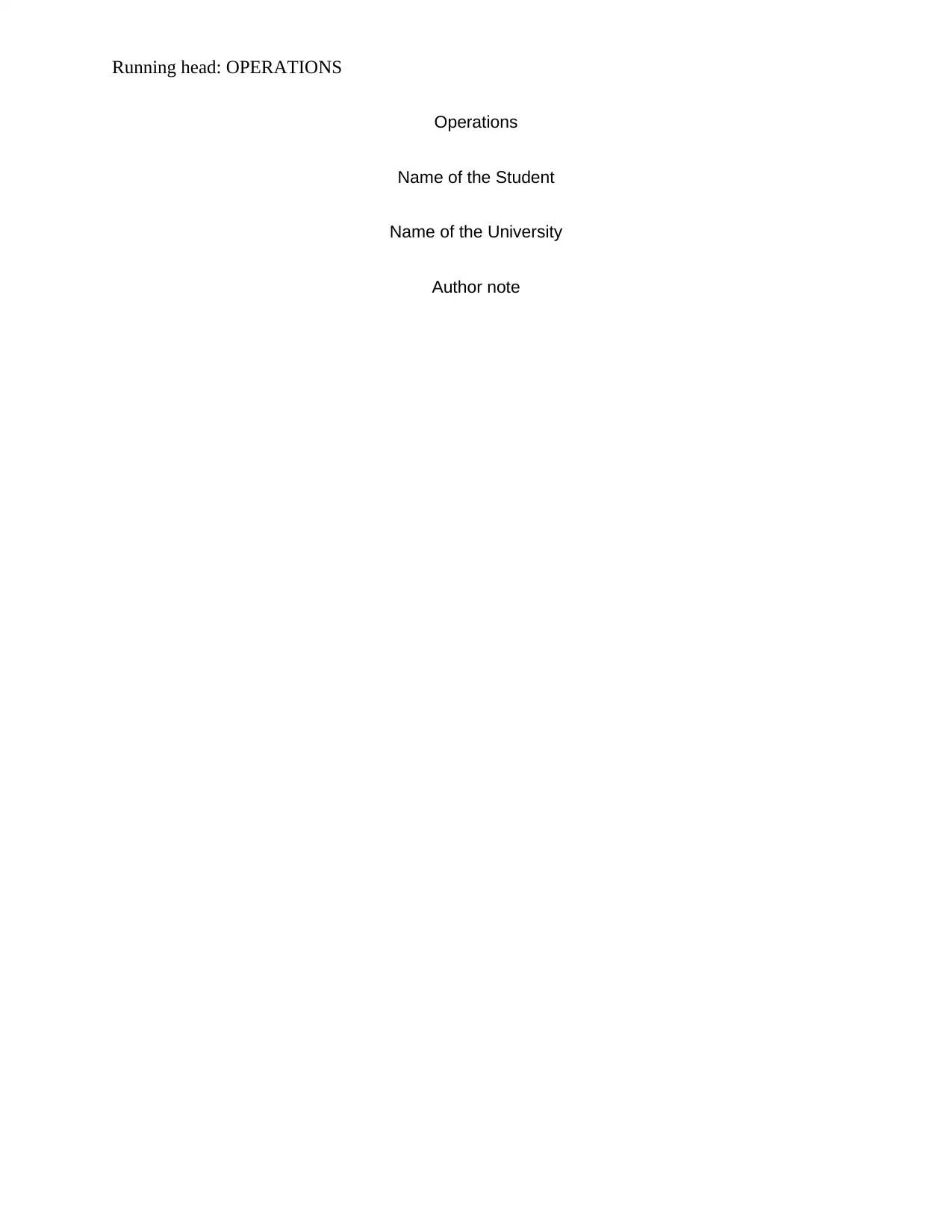
Running head: OPERATIONS
Operations
Name of the Student
Name of the University
Author note
Operations
Name of the Student
Name of the University
Author note
Secure Best Marks with AI Grader
Need help grading? Try our AI Grader for instant feedback on your assignments.
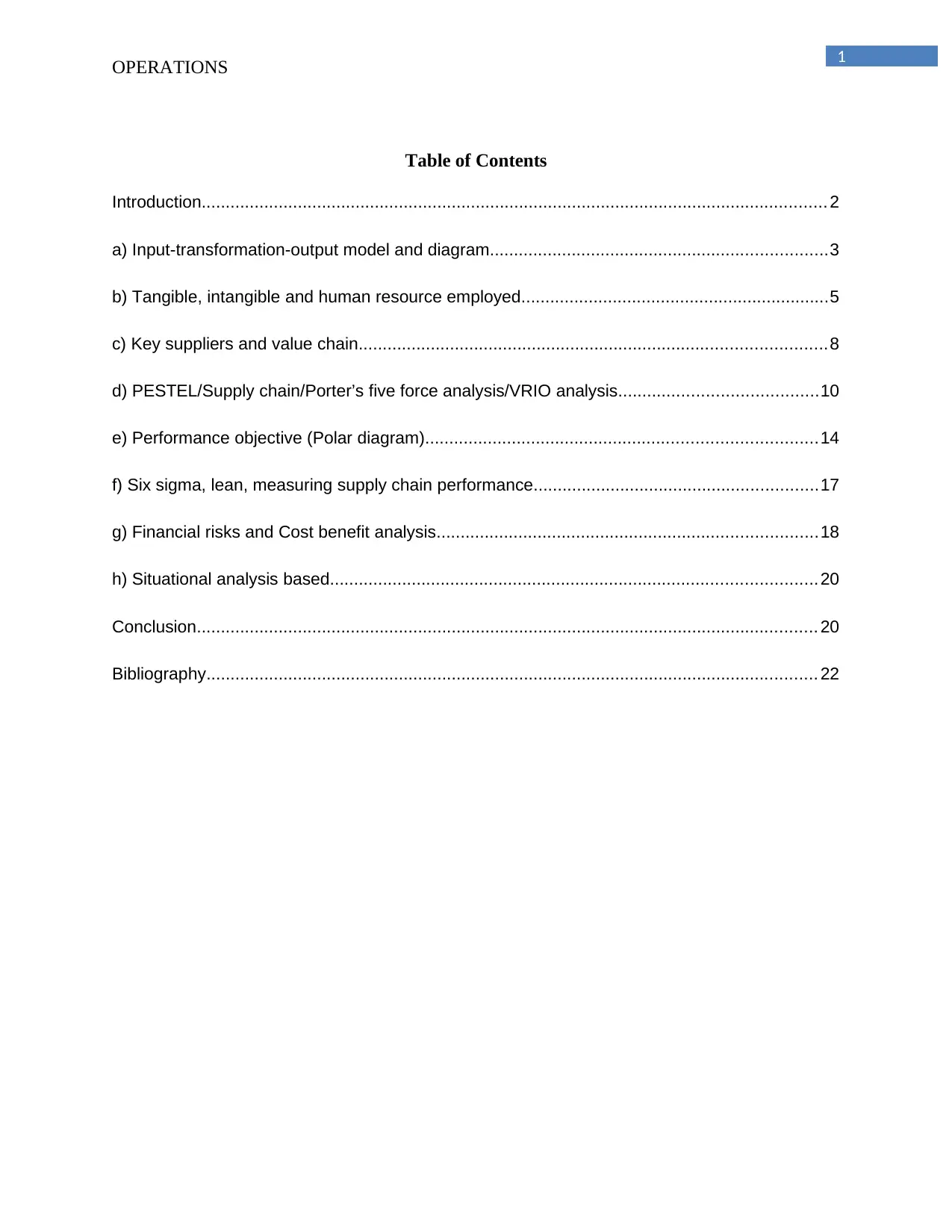
1
OPERATIONS
Table of Contents
Introduction.................................................................................................................................. 2
a) Input-transformation-output model and diagram......................................................................3
b) Tangible, intangible and human resource employed................................................................5
c) Key suppliers and value chain.................................................................................................8
d) PESTEL/Supply chain/Porter’s five force analysis/VRIO analysis.........................................10
e) Performance objective (Polar diagram).................................................................................14
f) Six sigma, lean, measuring supply chain performance...........................................................17
g) Financial risks and Cost benefit analysis...............................................................................18
h) Situational analysis based.....................................................................................................20
Conclusion................................................................................................................................. 20
Bibliography............................................................................................................................... 22
OPERATIONS
Table of Contents
Introduction.................................................................................................................................. 2
a) Input-transformation-output model and diagram......................................................................3
b) Tangible, intangible and human resource employed................................................................5
c) Key suppliers and value chain.................................................................................................8
d) PESTEL/Supply chain/Porter’s five force analysis/VRIO analysis.........................................10
e) Performance objective (Polar diagram).................................................................................14
f) Six sigma, lean, measuring supply chain performance...........................................................17
g) Financial risks and Cost benefit analysis...............................................................................18
h) Situational analysis based.....................................................................................................20
Conclusion................................................................................................................................. 20
Bibliography............................................................................................................................... 22
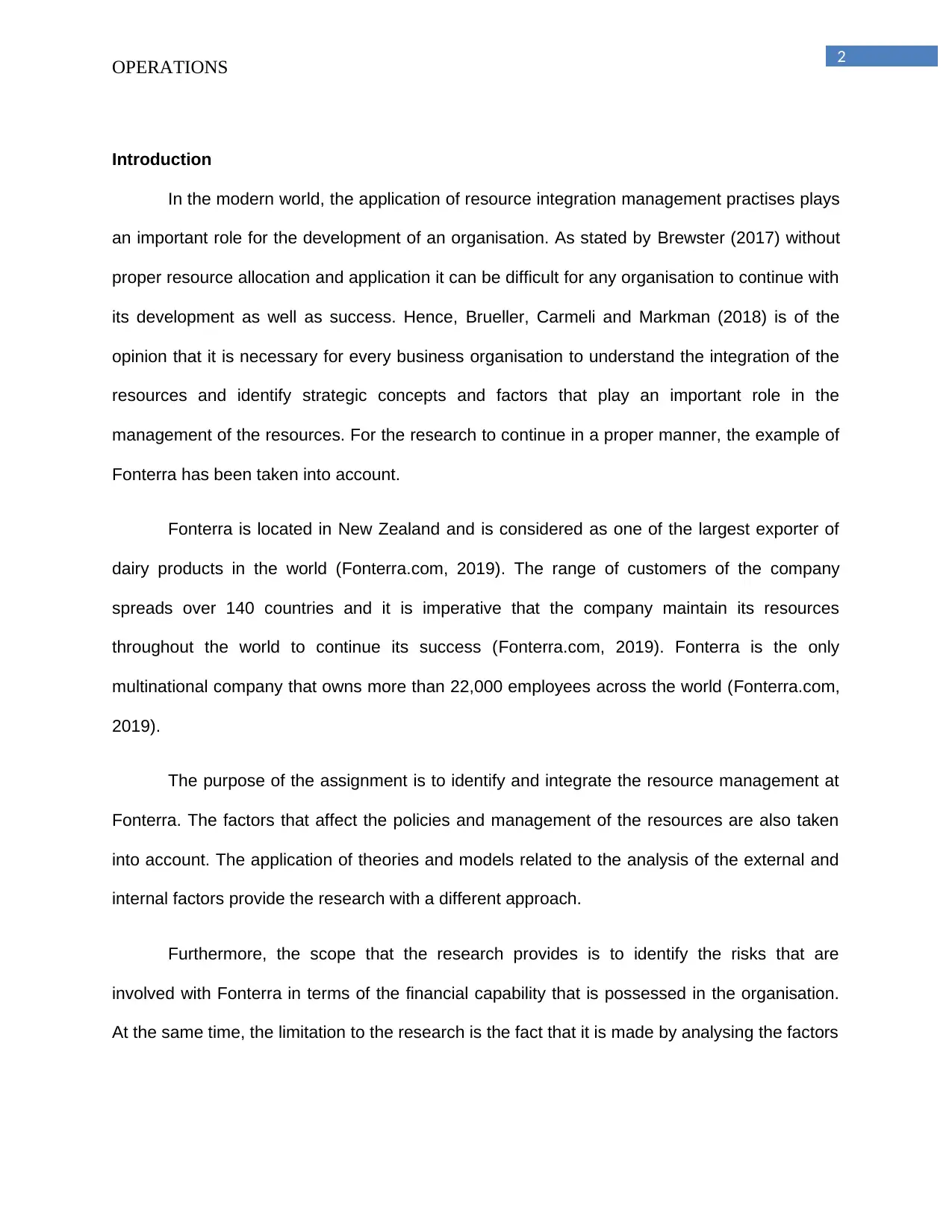
2
OPERATIONS
Introduction
In the modern world, the application of resource integration management practises plays
an important role for the development of an organisation. As stated by Brewster (2017) without
proper resource allocation and application it can be difficult for any organisation to continue with
its development as well as success. Hence, Brueller, Carmeli and Markman (2018) is of the
opinion that it is necessary for every business organisation to understand the integration of the
resources and identify strategic concepts and factors that play an important role in the
management of the resources. For the research to continue in a proper manner, the example of
Fonterra has been taken into account.
Fonterra is located in New Zealand and is considered as one of the largest exporter of
dairy products in the world (Fonterra.com, 2019). The range of customers of the company
spreads over 140 countries and it is imperative that the company maintain its resources
throughout the world to continue its success (Fonterra.com, 2019). Fonterra is the only
multinational company that owns more than 22,000 employees across the world (Fonterra.com,
2019).
The purpose of the assignment is to identify and integrate the resource management at
Fonterra. The factors that affect the policies and management of the resources are also taken
into account. The application of theories and models related to the analysis of the external and
internal factors provide the research with a different approach.
Furthermore, the scope that the research provides is to identify the risks that are
involved with Fonterra in terms of the financial capability that is possessed in the organisation.
At the same time, the limitation to the research is the fact that it is made by analysing the factors
OPERATIONS
Introduction
In the modern world, the application of resource integration management practises plays
an important role for the development of an organisation. As stated by Brewster (2017) without
proper resource allocation and application it can be difficult for any organisation to continue with
its development as well as success. Hence, Brueller, Carmeli and Markman (2018) is of the
opinion that it is necessary for every business organisation to understand the integration of the
resources and identify strategic concepts and factors that play an important role in the
management of the resources. For the research to continue in a proper manner, the example of
Fonterra has been taken into account.
Fonterra is located in New Zealand and is considered as one of the largest exporter of
dairy products in the world (Fonterra.com, 2019). The range of customers of the company
spreads over 140 countries and it is imperative that the company maintain its resources
throughout the world to continue its success (Fonterra.com, 2019). Fonterra is the only
multinational company that owns more than 22,000 employees across the world (Fonterra.com,
2019).
The purpose of the assignment is to identify and integrate the resource management at
Fonterra. The factors that affect the policies and management of the resources are also taken
into account. The application of theories and models related to the analysis of the external and
internal factors provide the research with a different approach.
Furthermore, the scope that the research provides is to identify the risks that are
involved with Fonterra in terms of the financial capability that is possessed in the organisation.
At the same time, the limitation to the research is the fact that it is made by analysing the factors
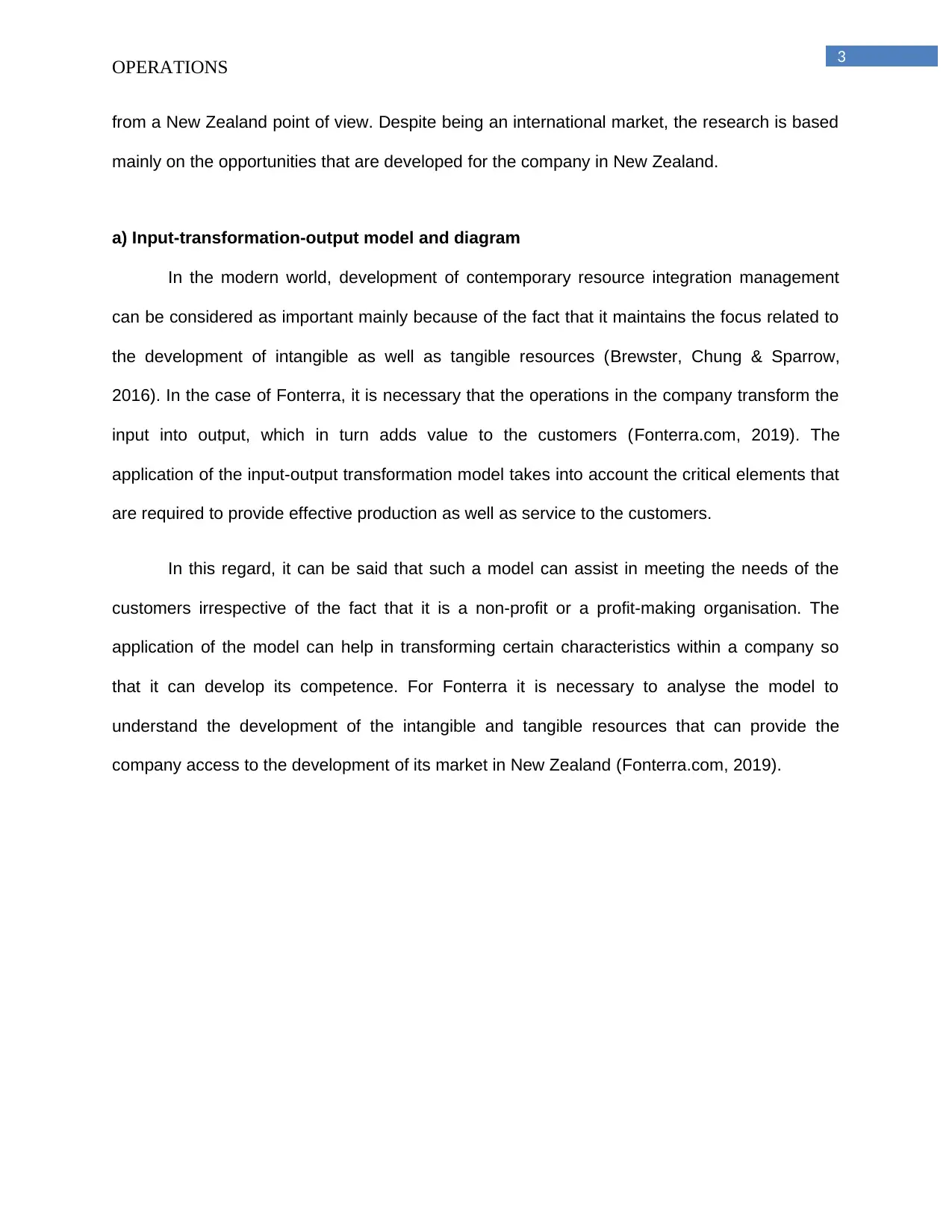
3
OPERATIONS
from a New Zealand point of view. Despite being an international market, the research is based
mainly on the opportunities that are developed for the company in New Zealand.
a) Input-transformation-output model and diagram
In the modern world, development of contemporary resource integration management
can be considered as important mainly because of the fact that it maintains the focus related to
the development of intangible as well as tangible resources (Brewster, Chung & Sparrow,
2016). In the case of Fonterra, it is necessary that the operations in the company transform the
input into output, which in turn adds value to the customers (Fonterra.com, 2019). The
application of the input-output transformation model takes into account the critical elements that
are required to provide effective production as well as service to the customers.
In this regard, it can be said that such a model can assist in meeting the needs of the
customers irrespective of the fact that it is a non-profit or a profit-making organisation. The
application of the model can help in transforming certain characteristics within a company so
that it can develop its competence. For Fonterra it is necessary to analyse the model to
understand the development of the intangible and tangible resources that can provide the
company access to the development of its market in New Zealand (Fonterra.com, 2019).
OPERATIONS
from a New Zealand point of view. Despite being an international market, the research is based
mainly on the opportunities that are developed for the company in New Zealand.
a) Input-transformation-output model and diagram
In the modern world, development of contemporary resource integration management
can be considered as important mainly because of the fact that it maintains the focus related to
the development of intangible as well as tangible resources (Brewster, Chung & Sparrow,
2016). In the case of Fonterra, it is necessary that the operations in the company transform the
input into output, which in turn adds value to the customers (Fonterra.com, 2019). The
application of the input-output transformation model takes into account the critical elements that
are required to provide effective production as well as service to the customers.
In this regard, it can be said that such a model can assist in meeting the needs of the
customers irrespective of the fact that it is a non-profit or a profit-making organisation. The
application of the model can help in transforming certain characteristics within a company so
that it can develop its competence. For Fonterra it is necessary to analyse the model to
understand the development of the intangible and tangible resources that can provide the
company access to the development of its market in New Zealand (Fonterra.com, 2019).
Secure Best Marks with AI Grader
Need help grading? Try our AI Grader for instant feedback on your assignments.

4
OPERATIONS
Figure 1: Input-output transformation model of Fonterra
(Source: Created by author)
The analysis of the model signifies that the inputs that are required for the development
of resources include the capital, materials, equipment, facilities as well as the labour associated
with the company. It has been seen that for Fonterra, the input process can be considered as
the tangible assets that the company possess (Fonterra.com, 2019). The application of the
assets can help Fonterra to understand the requirements and expectations from the business so
that decision regarding the development of the manufacturing process can be made
(Fonterra.com, 2019).
It is evidenced that the manufacturing unit of Fonterra provides the company with an
opportunity to deliver products to the customers quickly (Fonterra.com, 2019). Facilities located
in Whareroa and Cladeboye manufacture the highest production of milk and milk products that
are supplied all over the world (Fonterra.com, 2019). Therefore, as stated by Brewster,
Mayrhofer and Morley (2016) the requirements in terms of materials and equipments are
InputCapitalMaterialsEquipmentsFacilitiesLabourTransformationAlterationStorageInspectionOutputFacilitationofgoodsandservicesPropercustomerloyaltyAnalysisofthecomeptitors
OPERATIONS
Figure 1: Input-output transformation model of Fonterra
(Source: Created by author)
The analysis of the model signifies that the inputs that are required for the development
of resources include the capital, materials, equipment, facilities as well as the labour associated
with the company. It has been seen that for Fonterra, the input process can be considered as
the tangible assets that the company possess (Fonterra.com, 2019). The application of the
assets can help Fonterra to understand the requirements and expectations from the business so
that decision regarding the development of the manufacturing process can be made
(Fonterra.com, 2019).
It is evidenced that the manufacturing unit of Fonterra provides the company with an
opportunity to deliver products to the customers quickly (Fonterra.com, 2019). Facilities located
in Whareroa and Cladeboye manufacture the highest production of milk and milk products that
are supplied all over the world (Fonterra.com, 2019). Therefore, as stated by Brewster,
Mayrhofer and Morley (2016) the requirements in terms of materials and equipments are
InputCapitalMaterialsEquipmentsFacilitiesLabourTransformationAlterationStorageInspectionOutputFacilitationofgoodsandservicesPropercustomerloyaltyAnalysisofthecomeptitors
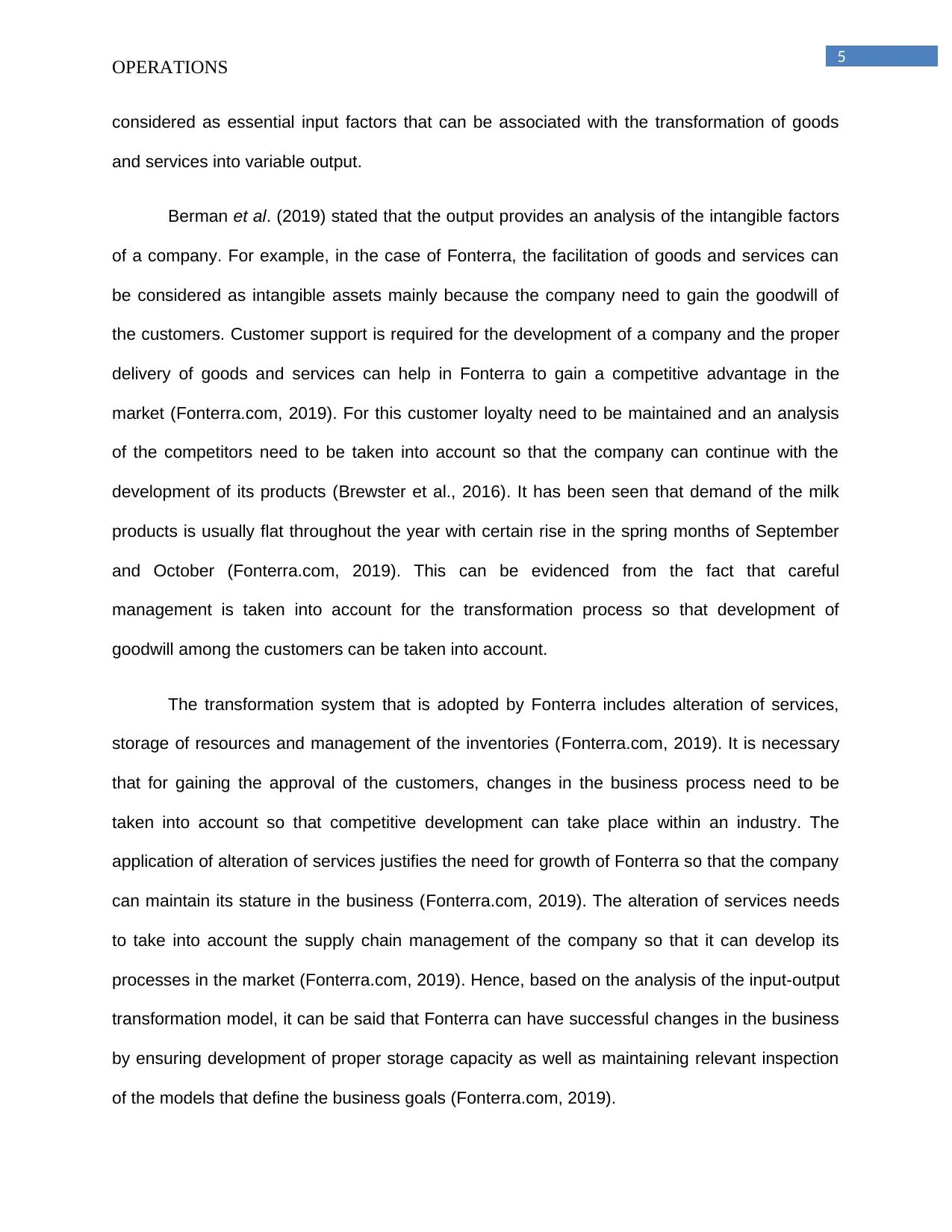
5
OPERATIONS
considered as essential input factors that can be associated with the transformation of goods
and services into variable output.
Berman et al. (2019) stated that the output provides an analysis of the intangible factors
of a company. For example, in the case of Fonterra, the facilitation of goods and services can
be considered as intangible assets mainly because the company need to gain the goodwill of
the customers. Customer support is required for the development of a company and the proper
delivery of goods and services can help in Fonterra to gain a competitive advantage in the
market (Fonterra.com, 2019). For this customer loyalty need to be maintained and an analysis
of the competitors need to be taken into account so that the company can continue with the
development of its products (Brewster et al., 2016). It has been seen that demand of the milk
products is usually flat throughout the year with certain rise in the spring months of September
and October (Fonterra.com, 2019). This can be evidenced from the fact that careful
management is taken into account for the transformation process so that development of
goodwill among the customers can be taken into account.
The transformation system that is adopted by Fonterra includes alteration of services,
storage of resources and management of the inventories (Fonterra.com, 2019). It is necessary
that for gaining the approval of the customers, changes in the business process need to be
taken into account so that competitive development can take place within an industry. The
application of alteration of services justifies the need for growth of Fonterra so that the company
can maintain its stature in the business (Fonterra.com, 2019). The alteration of services needs
to take into account the supply chain management of the company so that it can develop its
processes in the market (Fonterra.com, 2019). Hence, based on the analysis of the input-output
transformation model, it can be said that Fonterra can have successful changes in the business
by ensuring development of proper storage capacity as well as maintaining relevant inspection
of the models that define the business goals (Fonterra.com, 2019).
OPERATIONS
considered as essential input factors that can be associated with the transformation of goods
and services into variable output.
Berman et al. (2019) stated that the output provides an analysis of the intangible factors
of a company. For example, in the case of Fonterra, the facilitation of goods and services can
be considered as intangible assets mainly because the company need to gain the goodwill of
the customers. Customer support is required for the development of a company and the proper
delivery of goods and services can help in Fonterra to gain a competitive advantage in the
market (Fonterra.com, 2019). For this customer loyalty need to be maintained and an analysis
of the competitors need to be taken into account so that the company can continue with the
development of its products (Brewster et al., 2016). It has been seen that demand of the milk
products is usually flat throughout the year with certain rise in the spring months of September
and October (Fonterra.com, 2019). This can be evidenced from the fact that careful
management is taken into account for the transformation process so that development of
goodwill among the customers can be taken into account.
The transformation system that is adopted by Fonterra includes alteration of services,
storage of resources and management of the inventories (Fonterra.com, 2019). It is necessary
that for gaining the approval of the customers, changes in the business process need to be
taken into account so that competitive development can take place within an industry. The
application of alteration of services justifies the need for growth of Fonterra so that the company
can maintain its stature in the business (Fonterra.com, 2019). The alteration of services needs
to take into account the supply chain management of the company so that it can develop its
processes in the market (Fonterra.com, 2019). Hence, based on the analysis of the input-output
transformation model, it can be said that Fonterra can have successful changes in the business
by ensuring development of proper storage capacity as well as maintaining relevant inspection
of the models that define the business goals (Fonterra.com, 2019).
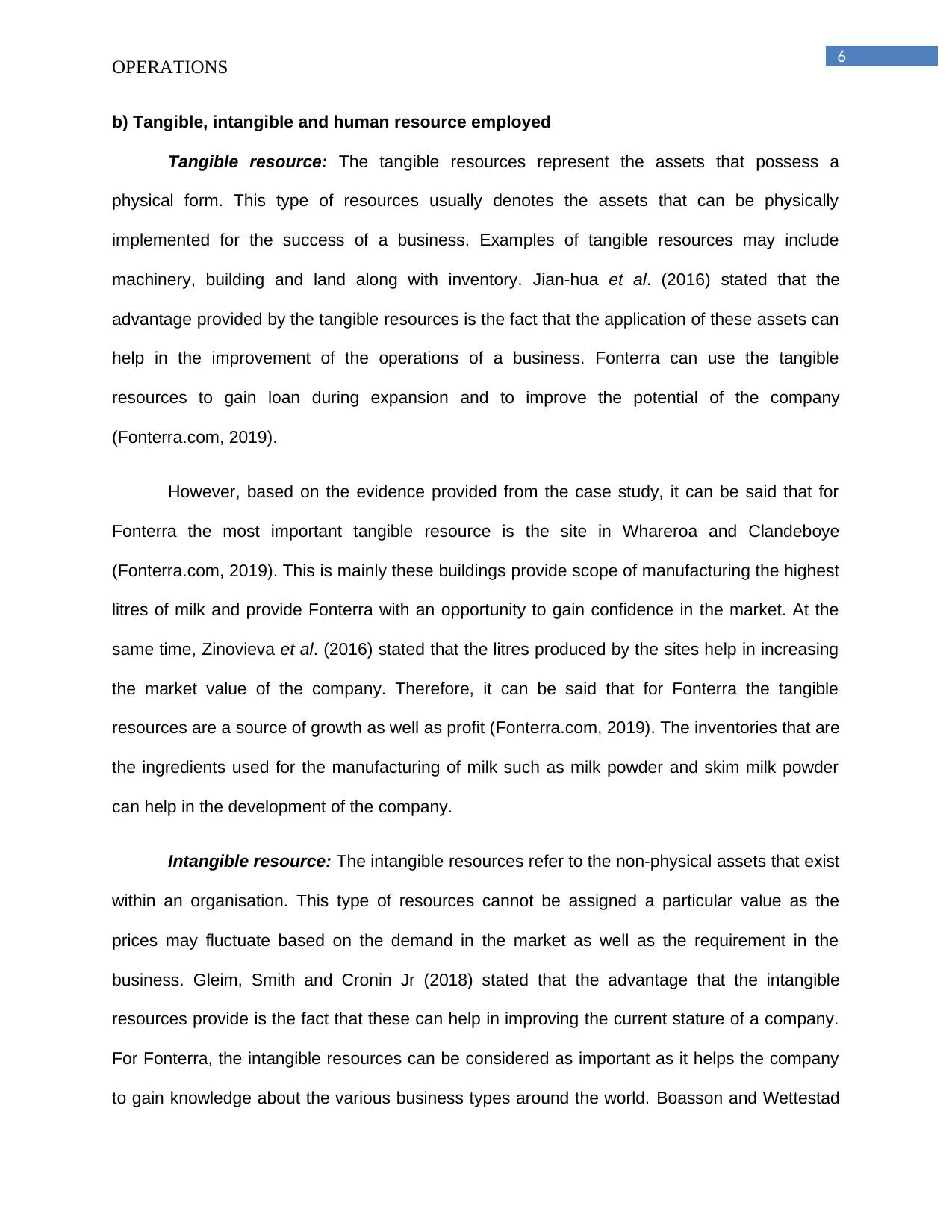
6
OPERATIONS
b) Tangible, intangible and human resource employed
Tangible resource: The tangible resources represent the assets that possess a
physical form. This type of resources usually denotes the assets that can be physically
implemented for the success of a business. Examples of tangible resources may include
machinery, building and land along with inventory. Jian-hua et al. (2016) stated that the
advantage provided by the tangible resources is the fact that the application of these assets can
help in the improvement of the operations of a business. Fonterra can use the tangible
resources to gain loan during expansion and to improve the potential of the company
(Fonterra.com, 2019).
However, based on the evidence provided from the case study, it can be said that for
Fonterra the most important tangible resource is the site in Whareroa and Clandeboye
(Fonterra.com, 2019). This is mainly these buildings provide scope of manufacturing the highest
litres of milk and provide Fonterra with an opportunity to gain confidence in the market. At the
same time, Zinovieva et al. (2016) stated that the litres produced by the sites help in increasing
the market value of the company. Therefore, it can be said that for Fonterra the tangible
resources are a source of growth as well as profit (Fonterra.com, 2019). The inventories that are
the ingredients used for the manufacturing of milk such as milk powder and skim milk powder
can help in the development of the company.
Intangible resource: The intangible resources refer to the non-physical assets that exist
within an organisation. This type of resources cannot be assigned a particular value as the
prices may fluctuate based on the demand in the market as well as the requirement in the
business. Gleim, Smith and Cronin Jr (2018) stated that the advantage that the intangible
resources provide is the fact that these can help in improving the current stature of a company.
For Fonterra, the intangible resources can be considered as important as it helps the company
to gain knowledge about the various business types around the world. Boasson and Wettestad
OPERATIONS
b) Tangible, intangible and human resource employed
Tangible resource: The tangible resources represent the assets that possess a
physical form. This type of resources usually denotes the assets that can be physically
implemented for the success of a business. Examples of tangible resources may include
machinery, building and land along with inventory. Jian-hua et al. (2016) stated that the
advantage provided by the tangible resources is the fact that the application of these assets can
help in the improvement of the operations of a business. Fonterra can use the tangible
resources to gain loan during expansion and to improve the potential of the company
(Fonterra.com, 2019).
However, based on the evidence provided from the case study, it can be said that for
Fonterra the most important tangible resource is the site in Whareroa and Clandeboye
(Fonterra.com, 2019). This is mainly these buildings provide scope of manufacturing the highest
litres of milk and provide Fonterra with an opportunity to gain confidence in the market. At the
same time, Zinovieva et al. (2016) stated that the litres produced by the sites help in increasing
the market value of the company. Therefore, it can be said that for Fonterra the tangible
resources are a source of growth as well as profit (Fonterra.com, 2019). The inventories that are
the ingredients used for the manufacturing of milk such as milk powder and skim milk powder
can help in the development of the company.
Intangible resource: The intangible resources refer to the non-physical assets that exist
within an organisation. This type of resources cannot be assigned a particular value as the
prices may fluctuate based on the demand in the market as well as the requirement in the
business. Gleim, Smith and Cronin Jr (2018) stated that the advantage that the intangible
resources provide is the fact that these can help in improving the current stature of a company.
For Fonterra, the intangible resources can be considered as important as it helps the company
to gain knowledge about the various business types around the world. Boasson and Wettestad
Paraphrase This Document
Need a fresh take? Get an instant paraphrase of this document with our AI Paraphraser
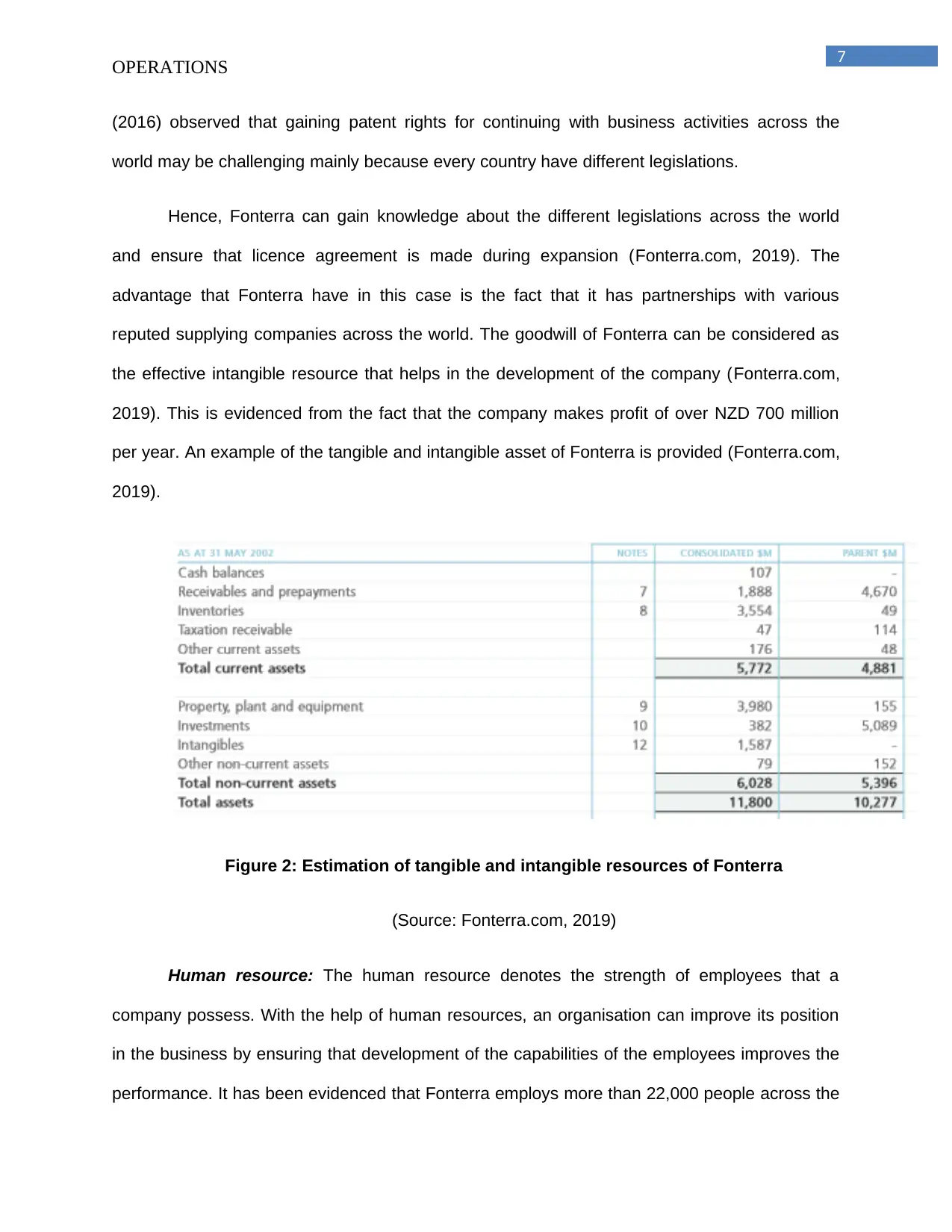
7
OPERATIONS
(2016) observed that gaining patent rights for continuing with business activities across the
world may be challenging mainly because every country have different legislations.
Hence, Fonterra can gain knowledge about the different legislations across the world
and ensure that licence agreement is made during expansion (Fonterra.com, 2019). The
advantage that Fonterra have in this case is the fact that it has partnerships with various
reputed supplying companies across the world. The goodwill of Fonterra can be considered as
the effective intangible resource that helps in the development of the company (Fonterra.com,
2019). This is evidenced from the fact that the company makes profit of over NZD 700 million
per year. An example of the tangible and intangible asset of Fonterra is provided (Fonterra.com,
2019).
Figure 2: Estimation of tangible and intangible resources of Fonterra
(Source: Fonterra.com, 2019)
Human resource: The human resource denotes the strength of employees that a
company possess. With the help of human resources, an organisation can improve its position
in the business by ensuring that development of the capabilities of the employees improves the
performance. It has been evidenced that Fonterra employs more than 22,000 people across the
OPERATIONS
(2016) observed that gaining patent rights for continuing with business activities across the
world may be challenging mainly because every country have different legislations.
Hence, Fonterra can gain knowledge about the different legislations across the world
and ensure that licence agreement is made during expansion (Fonterra.com, 2019). The
advantage that Fonterra have in this case is the fact that it has partnerships with various
reputed supplying companies across the world. The goodwill of Fonterra can be considered as
the effective intangible resource that helps in the development of the company (Fonterra.com,
2019). This is evidenced from the fact that the company makes profit of over NZD 700 million
per year. An example of the tangible and intangible asset of Fonterra is provided (Fonterra.com,
2019).
Figure 2: Estimation of tangible and intangible resources of Fonterra
(Source: Fonterra.com, 2019)
Human resource: The human resource denotes the strength of employees that a
company possess. With the help of human resources, an organisation can improve its position
in the business by ensuring that development of the capabilities of the employees improves the
performance. It has been evidenced that Fonterra employs more than 22,000 people across the
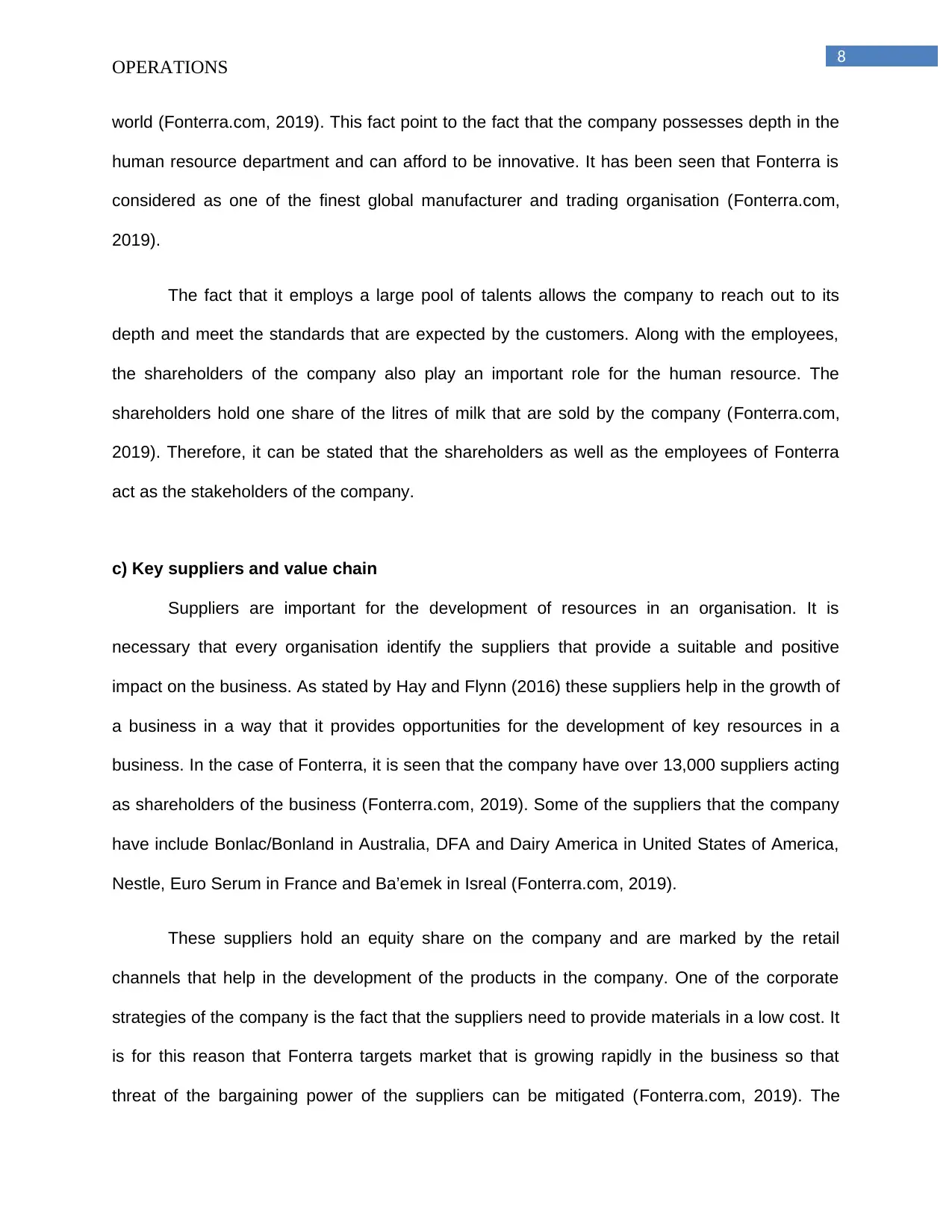
8
OPERATIONS
world (Fonterra.com, 2019). This fact point to the fact that the company possesses depth in the
human resource department and can afford to be innovative. It has been seen that Fonterra is
considered as one of the finest global manufacturer and trading organisation (Fonterra.com,
2019).
The fact that it employs a large pool of talents allows the company to reach out to its
depth and meet the standards that are expected by the customers. Along with the employees,
the shareholders of the company also play an important role for the human resource. The
shareholders hold one share of the litres of milk that are sold by the company (Fonterra.com,
2019). Therefore, it can be stated that the shareholders as well as the employees of Fonterra
act as the stakeholders of the company.
c) Key suppliers and value chain
Suppliers are important for the development of resources in an organisation. It is
necessary that every organisation identify the suppliers that provide a suitable and positive
impact on the business. As stated by Hay and Flynn (2016) these suppliers help in the growth of
a business in a way that it provides opportunities for the development of key resources in a
business. In the case of Fonterra, it is seen that the company have over 13,000 suppliers acting
as shareholders of the business (Fonterra.com, 2019). Some of the suppliers that the company
have include Bonlac/Bonland in Australia, DFA and Dairy America in United States of America,
Nestle, Euro Serum in France and Ba’emek in Isreal (Fonterra.com, 2019).
These suppliers hold an equity share on the company and are marked by the retail
channels that help in the development of the products in the company. One of the corporate
strategies of the company is the fact that the suppliers need to provide materials in a low cost. It
is for this reason that Fonterra targets market that is growing rapidly in the business so that
threat of the bargaining power of the suppliers can be mitigated (Fonterra.com, 2019). The
OPERATIONS
world (Fonterra.com, 2019). This fact point to the fact that the company possesses depth in the
human resource department and can afford to be innovative. It has been seen that Fonterra is
considered as one of the finest global manufacturer and trading organisation (Fonterra.com,
2019).
The fact that it employs a large pool of talents allows the company to reach out to its
depth and meet the standards that are expected by the customers. Along with the employees,
the shareholders of the company also play an important role for the human resource. The
shareholders hold one share of the litres of milk that are sold by the company (Fonterra.com,
2019). Therefore, it can be stated that the shareholders as well as the employees of Fonterra
act as the stakeholders of the company.
c) Key suppliers and value chain
Suppliers are important for the development of resources in an organisation. It is
necessary that every organisation identify the suppliers that provide a suitable and positive
impact on the business. As stated by Hay and Flynn (2016) these suppliers help in the growth of
a business in a way that it provides opportunities for the development of key resources in a
business. In the case of Fonterra, it is seen that the company have over 13,000 suppliers acting
as shareholders of the business (Fonterra.com, 2019). Some of the suppliers that the company
have include Bonlac/Bonland in Australia, DFA and Dairy America in United States of America,
Nestle, Euro Serum in France and Ba’emek in Isreal (Fonterra.com, 2019).
These suppliers hold an equity share on the company and are marked by the retail
channels that help in the development of the products in the company. One of the corporate
strategies of the company is the fact that the suppliers need to provide materials in a low cost. It
is for this reason that Fonterra targets market that is growing rapidly in the business so that
threat of the bargaining power of the suppliers can be mitigated (Fonterra.com, 2019). The

9
OPERATIONS
partnerships that Fonterra have with the suppliers around the world can account for the
development of the company.
Chen et al. (2018) stated that the support from the suppliers is important as it can help in
the development of the brand of the company. In this regard, it can be said that for Fonterra the
suppliers are deemed as expensive mainly because the company has to pay about NZD 5,000
per month to keep the gains from the suppliers afloat (Fonterra.com, 2019). The suppliers also
play a crucial role in the development of the value chain of a company as it defines the sales
and marketing techniques required for continuing with the growth (Hoareau et al., 2017).
The value chain analysis identifies the effectiveness of the activities that every
organisation operating in specific industries performs so that valuable products can be
developed. Value chain as a decision support tool can be considered as a competitive strategy
mainly because the concept is based on the views of the organisations. In the case of Fonterra,
the value chain analysis of the company describes the important factors necessary for the
development of the company. The value chain criteria and analysis of Fonterra is provided
OPERATIONS
partnerships that Fonterra have with the suppliers around the world can account for the
development of the company.
Chen et al. (2018) stated that the support from the suppliers is important as it can help in
the development of the brand of the company. In this regard, it can be said that for Fonterra the
suppliers are deemed as expensive mainly because the company has to pay about NZD 5,000
per month to keep the gains from the suppliers afloat (Fonterra.com, 2019). The suppliers also
play a crucial role in the development of the value chain of a company as it defines the sales
and marketing techniques required for continuing with the growth (Hoareau et al., 2017).
The value chain analysis identifies the effectiveness of the activities that every
organisation operating in specific industries performs so that valuable products can be
developed. Value chain as a decision support tool can be considered as a competitive strategy
mainly because the concept is based on the views of the organisations. In the case of Fonterra,
the value chain analysis of the company describes the important factors necessary for the
development of the company. The value chain criteria and analysis of Fonterra is provided
Secure Best Marks with AI Grader
Need help grading? Try our AI Grader for instant feedback on your assignments.
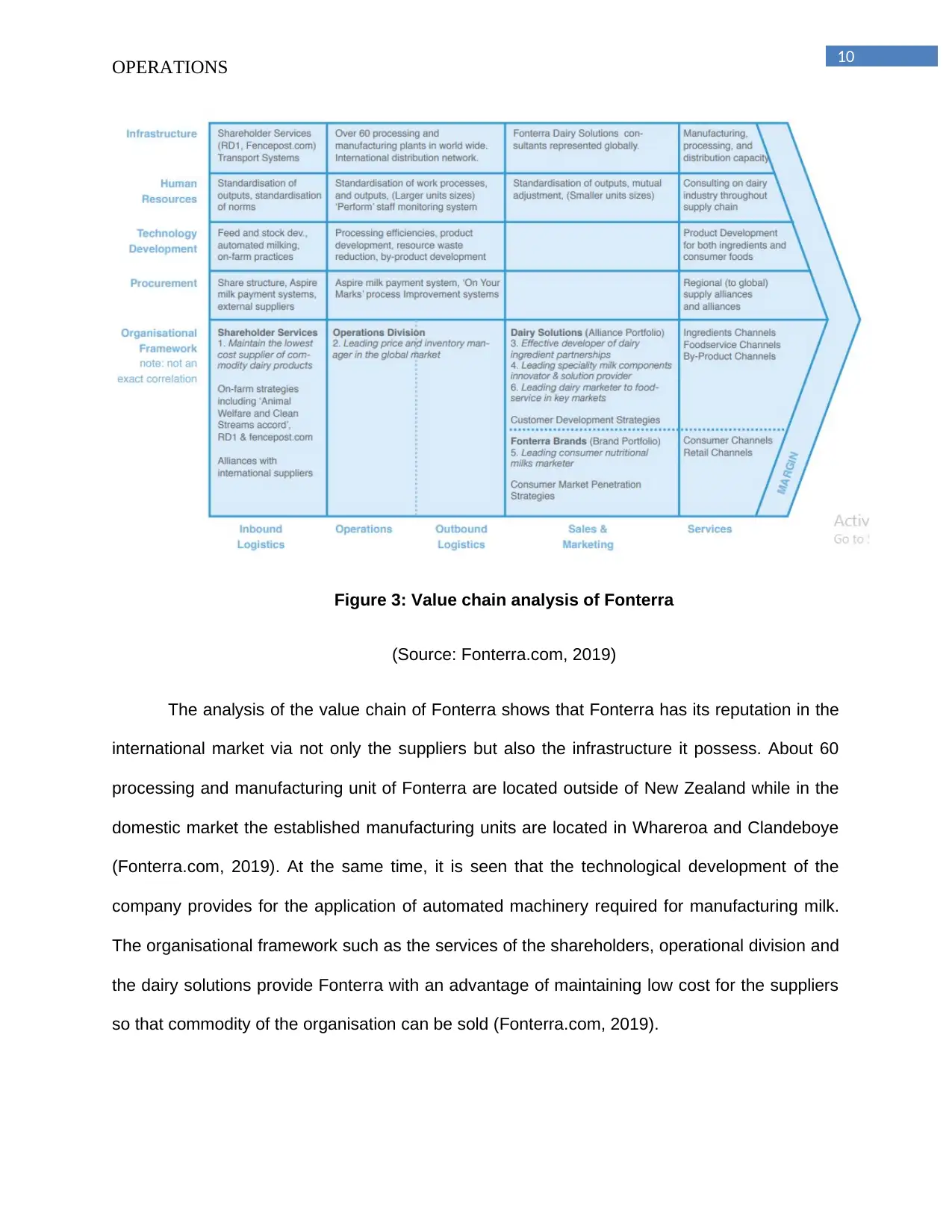
10
OPERATIONS
Figure 3: Value chain analysis of Fonterra
(Source: Fonterra.com, 2019)
The analysis of the value chain of Fonterra shows that Fonterra has its reputation in the
international market via not only the suppliers but also the infrastructure it possess. About 60
processing and manufacturing unit of Fonterra are located outside of New Zealand while in the
domestic market the established manufacturing units are located in Whareroa and Clandeboye
(Fonterra.com, 2019). At the same time, it is seen that the technological development of the
company provides for the application of automated machinery required for manufacturing milk.
The organisational framework such as the services of the shareholders, operational division and
the dairy solutions provide Fonterra with an advantage of maintaining low cost for the suppliers
so that commodity of the organisation can be sold (Fonterra.com, 2019).
OPERATIONS
Figure 3: Value chain analysis of Fonterra
(Source: Fonterra.com, 2019)
The analysis of the value chain of Fonterra shows that Fonterra has its reputation in the
international market via not only the suppliers but also the infrastructure it possess. About 60
processing and manufacturing unit of Fonterra are located outside of New Zealand while in the
domestic market the established manufacturing units are located in Whareroa and Clandeboye
(Fonterra.com, 2019). At the same time, it is seen that the technological development of the
company provides for the application of automated machinery required for manufacturing milk.
The organisational framework such as the services of the shareholders, operational division and
the dairy solutions provide Fonterra with an advantage of maintaining low cost for the suppliers
so that commodity of the organisation can be sold (Fonterra.com, 2019).
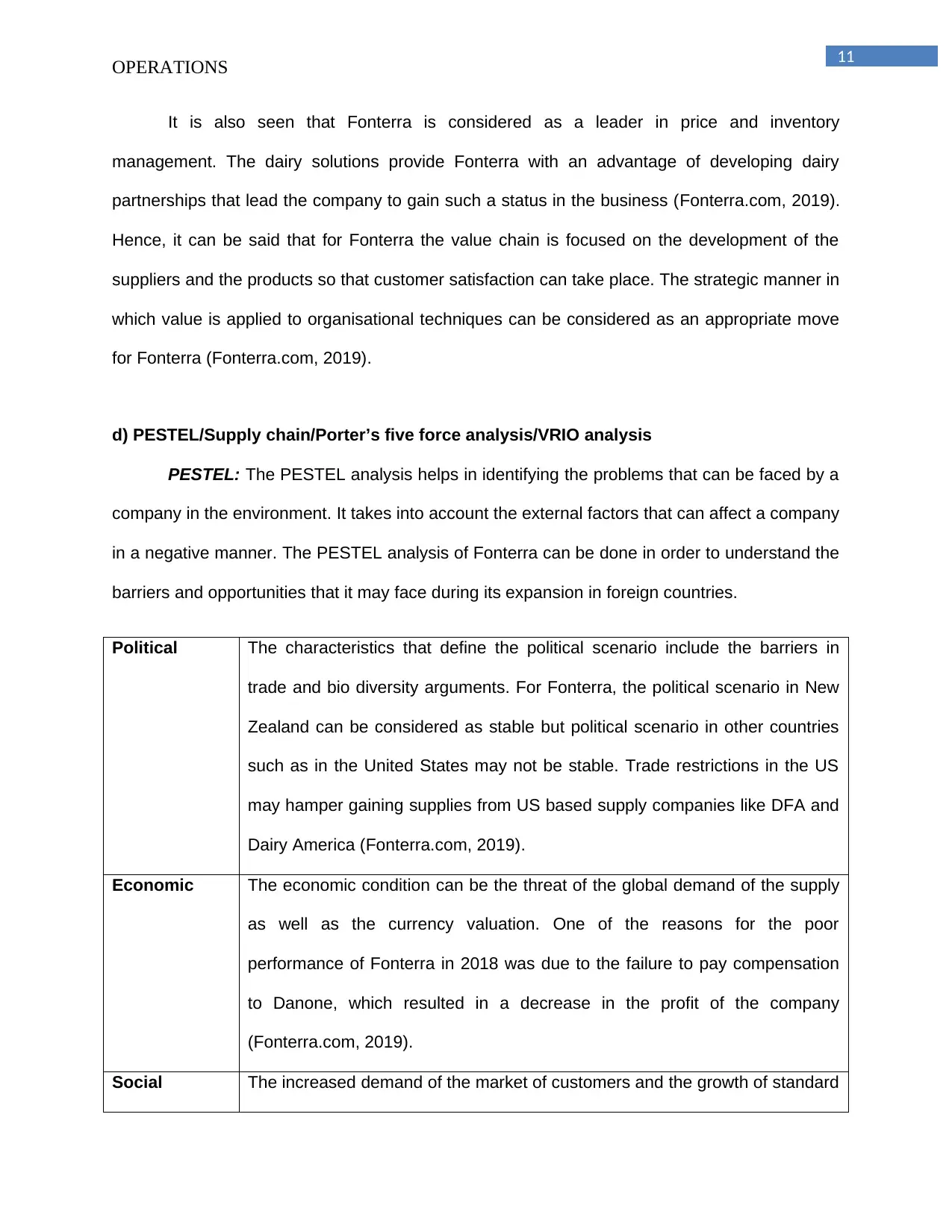
11
OPERATIONS
It is also seen that Fonterra is considered as a leader in price and inventory
management. The dairy solutions provide Fonterra with an advantage of developing dairy
partnerships that lead the company to gain such a status in the business (Fonterra.com, 2019).
Hence, it can be said that for Fonterra the value chain is focused on the development of the
suppliers and the products so that customer satisfaction can take place. The strategic manner in
which value is applied to organisational techniques can be considered as an appropriate move
for Fonterra (Fonterra.com, 2019).
d) PESTEL/Supply chain/Porter’s five force analysis/VRIO analysis
PESTEL: The PESTEL analysis helps in identifying the problems that can be faced by a
company in the environment. It takes into account the external factors that can affect a company
in a negative manner. The PESTEL analysis of Fonterra can be done in order to understand the
barriers and opportunities that it may face during its expansion in foreign countries.
Political The characteristics that define the political scenario include the barriers in
trade and bio diversity arguments. For Fonterra, the political scenario in New
Zealand can be considered as stable but political scenario in other countries
such as in the United States may not be stable. Trade restrictions in the US
may hamper gaining supplies from US based supply companies like DFA and
Dairy America (Fonterra.com, 2019).
Economic The economic condition can be the threat of the global demand of the supply
as well as the currency valuation. One of the reasons for the poor
performance of Fonterra in 2018 was due to the failure to pay compensation
to Danone, which resulted in a decrease in the profit of the company
(Fonterra.com, 2019).
Social The increased demand of the market of customers and the growth of standard
OPERATIONS
It is also seen that Fonterra is considered as a leader in price and inventory
management. The dairy solutions provide Fonterra with an advantage of developing dairy
partnerships that lead the company to gain such a status in the business (Fonterra.com, 2019).
Hence, it can be said that for Fonterra the value chain is focused on the development of the
suppliers and the products so that customer satisfaction can take place. The strategic manner in
which value is applied to organisational techniques can be considered as an appropriate move
for Fonterra (Fonterra.com, 2019).
d) PESTEL/Supply chain/Porter’s five force analysis/VRIO analysis
PESTEL: The PESTEL analysis helps in identifying the problems that can be faced by a
company in the environment. It takes into account the external factors that can affect a company
in a negative manner. The PESTEL analysis of Fonterra can be done in order to understand the
barriers and opportunities that it may face during its expansion in foreign countries.
Political The characteristics that define the political scenario include the barriers in
trade and bio diversity arguments. For Fonterra, the political scenario in New
Zealand can be considered as stable but political scenario in other countries
such as in the United States may not be stable. Trade restrictions in the US
may hamper gaining supplies from US based supply companies like DFA and
Dairy America (Fonterra.com, 2019).
Economic The economic condition can be the threat of the global demand of the supply
as well as the currency valuation. One of the reasons for the poor
performance of Fonterra in 2018 was due to the failure to pay compensation
to Danone, which resulted in a decrease in the profit of the company
(Fonterra.com, 2019).
Social The increased demand of the market of customers and the growth of standard
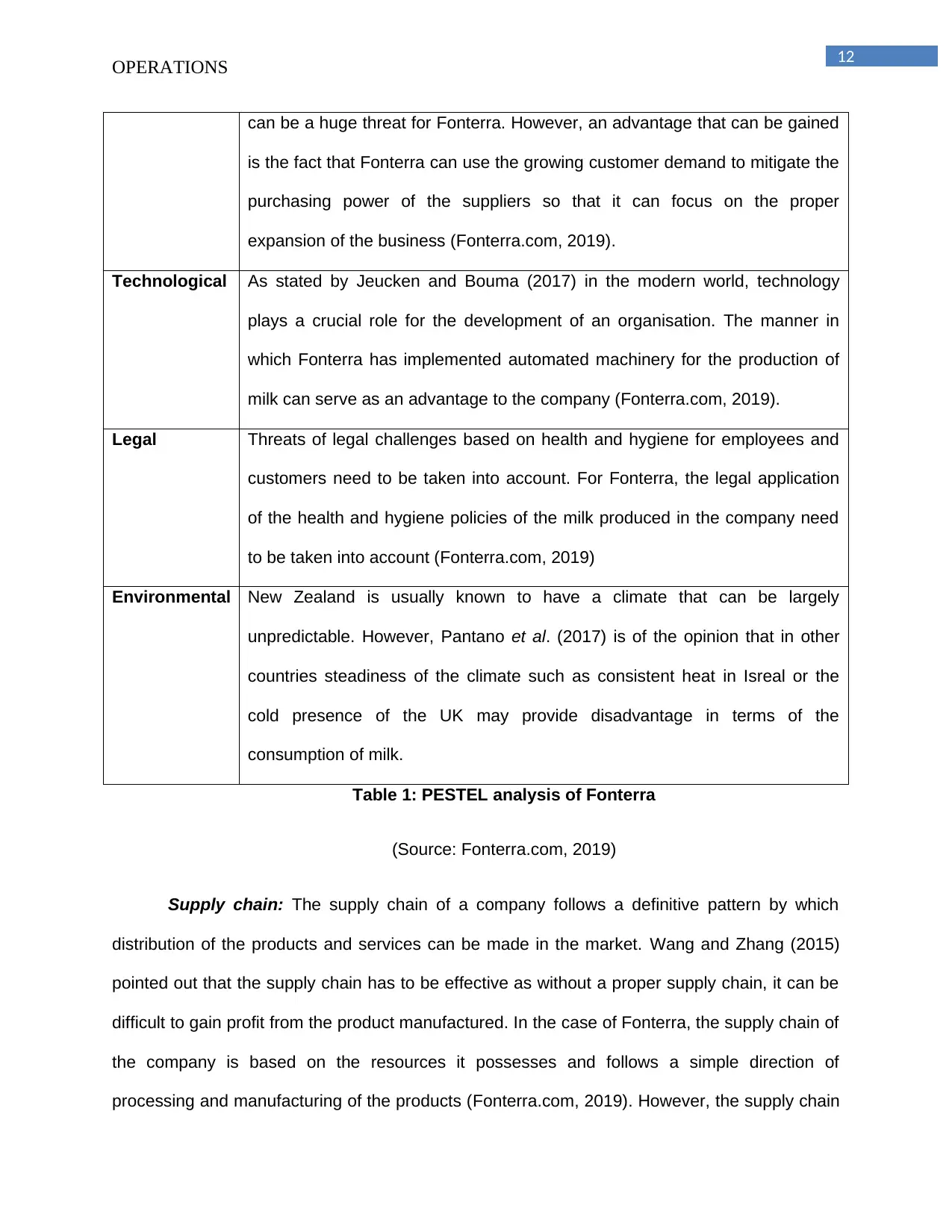
12
OPERATIONS
can be a huge threat for Fonterra. However, an advantage that can be gained
is the fact that Fonterra can use the growing customer demand to mitigate the
purchasing power of the suppliers so that it can focus on the proper
expansion of the business (Fonterra.com, 2019).
Technological As stated by Jeucken and Bouma (2017) in the modern world, technology
plays a crucial role for the development of an organisation. The manner in
which Fonterra has implemented automated machinery for the production of
milk can serve as an advantage to the company (Fonterra.com, 2019).
Legal Threats of legal challenges based on health and hygiene for employees and
customers need to be taken into account. For Fonterra, the legal application
of the health and hygiene policies of the milk produced in the company need
to be taken into account (Fonterra.com, 2019)
Environmental New Zealand is usually known to have a climate that can be largely
unpredictable. However, Pantano et al. (2017) is of the opinion that in other
countries steadiness of the climate such as consistent heat in Isreal or the
cold presence of the UK may provide disadvantage in terms of the
consumption of milk.
Table 1: PESTEL analysis of Fonterra
(Source: Fonterra.com, 2019)
Supply chain: The supply chain of a company follows a definitive pattern by which
distribution of the products and services can be made in the market. Wang and Zhang (2015)
pointed out that the supply chain has to be effective as without a proper supply chain, it can be
difficult to gain profit from the product manufactured. In the case of Fonterra, the supply chain of
the company is based on the resources it possesses and follows a simple direction of
processing and manufacturing of the products (Fonterra.com, 2019). However, the supply chain
OPERATIONS
can be a huge threat for Fonterra. However, an advantage that can be gained
is the fact that Fonterra can use the growing customer demand to mitigate the
purchasing power of the suppliers so that it can focus on the proper
expansion of the business (Fonterra.com, 2019).
Technological As stated by Jeucken and Bouma (2017) in the modern world, technology
plays a crucial role for the development of an organisation. The manner in
which Fonterra has implemented automated machinery for the production of
milk can serve as an advantage to the company (Fonterra.com, 2019).
Legal Threats of legal challenges based on health and hygiene for employees and
customers need to be taken into account. For Fonterra, the legal application
of the health and hygiene policies of the milk produced in the company need
to be taken into account (Fonterra.com, 2019)
Environmental New Zealand is usually known to have a climate that can be largely
unpredictable. However, Pantano et al. (2017) is of the opinion that in other
countries steadiness of the climate such as consistent heat in Isreal or the
cold presence of the UK may provide disadvantage in terms of the
consumption of milk.
Table 1: PESTEL analysis of Fonterra
(Source: Fonterra.com, 2019)
Supply chain: The supply chain of a company follows a definitive pattern by which
distribution of the products and services can be made in the market. Wang and Zhang (2015)
pointed out that the supply chain has to be effective as without a proper supply chain, it can be
difficult to gain profit from the product manufactured. In the case of Fonterra, the supply chain of
the company is based on the resources it possesses and follows a simple direction of
processing and manufacturing of the products (Fonterra.com, 2019). However, the supply chain
Paraphrase This Document
Need a fresh take? Get an instant paraphrase of this document with our AI Paraphraser
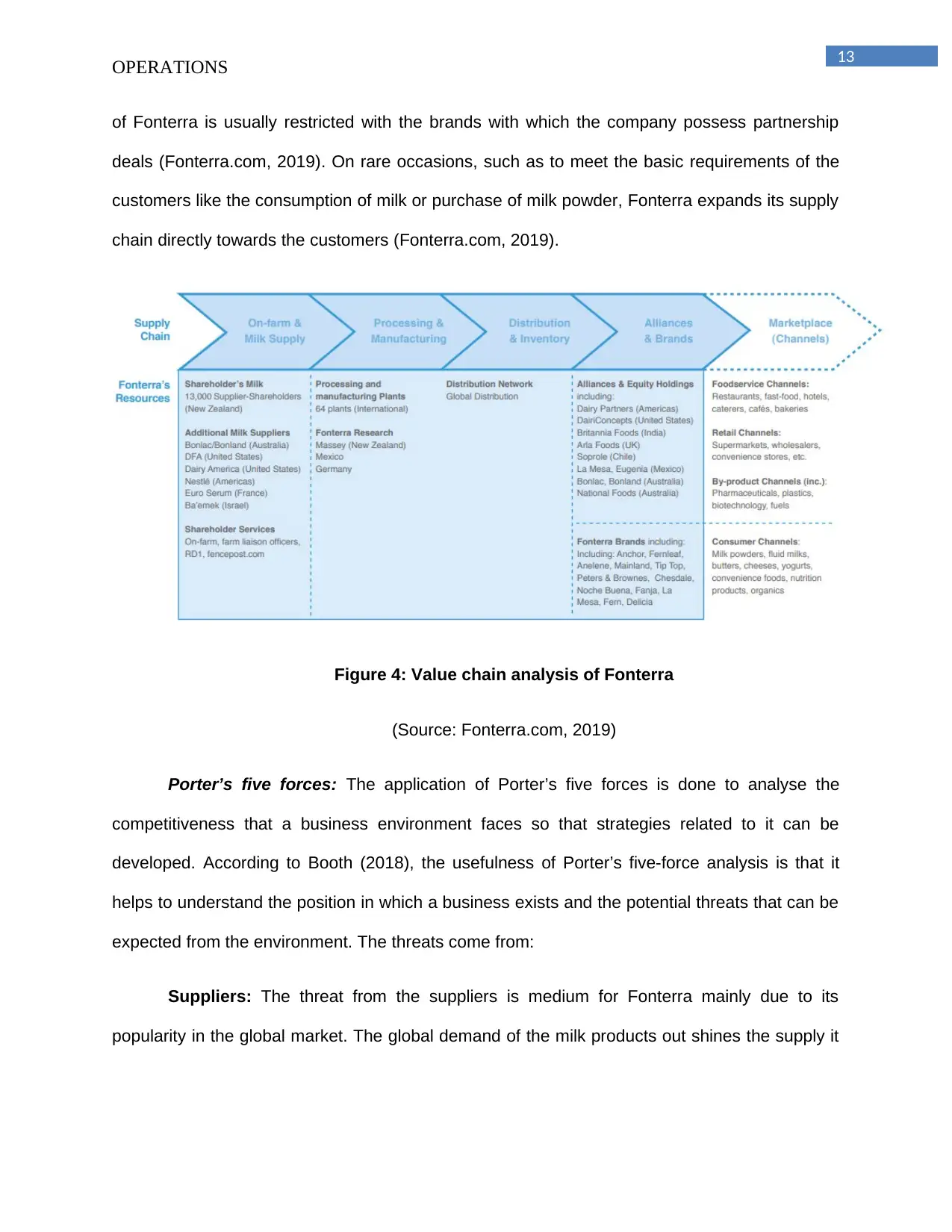
13
OPERATIONS
of Fonterra is usually restricted with the brands with which the company possess partnership
deals (Fonterra.com, 2019). On rare occasions, such as to meet the basic requirements of the
customers like the consumption of milk or purchase of milk powder, Fonterra expands its supply
chain directly towards the customers (Fonterra.com, 2019).
Figure 4: Value chain analysis of Fonterra
(Source: Fonterra.com, 2019)
Porter’s five forces: The application of Porter’s five forces is done to analyse the
competitiveness that a business environment faces so that strategies related to it can be
developed. According to Booth (2018), the usefulness of Porter’s five-force analysis is that it
helps to understand the position in which a business exists and the potential threats that can be
expected from the environment. The threats come from:
Suppliers: The threat from the suppliers is medium for Fonterra mainly due to its
popularity in the global market. The global demand of the milk products out shines the supply it
OPERATIONS
of Fonterra is usually restricted with the brands with which the company possess partnership
deals (Fonterra.com, 2019). On rare occasions, such as to meet the basic requirements of the
customers like the consumption of milk or purchase of milk powder, Fonterra expands its supply
chain directly towards the customers (Fonterra.com, 2019).
Figure 4: Value chain analysis of Fonterra
(Source: Fonterra.com, 2019)
Porter’s five forces: The application of Porter’s five forces is done to analyse the
competitiveness that a business environment faces so that strategies related to it can be
developed. According to Booth (2018), the usefulness of Porter’s five-force analysis is that it
helps to understand the position in which a business exists and the potential threats that can be
expected from the environment. The threats come from:
Suppliers: The threat from the suppliers is medium for Fonterra mainly due to its
popularity in the global market. The global demand of the milk products out shines the supply it
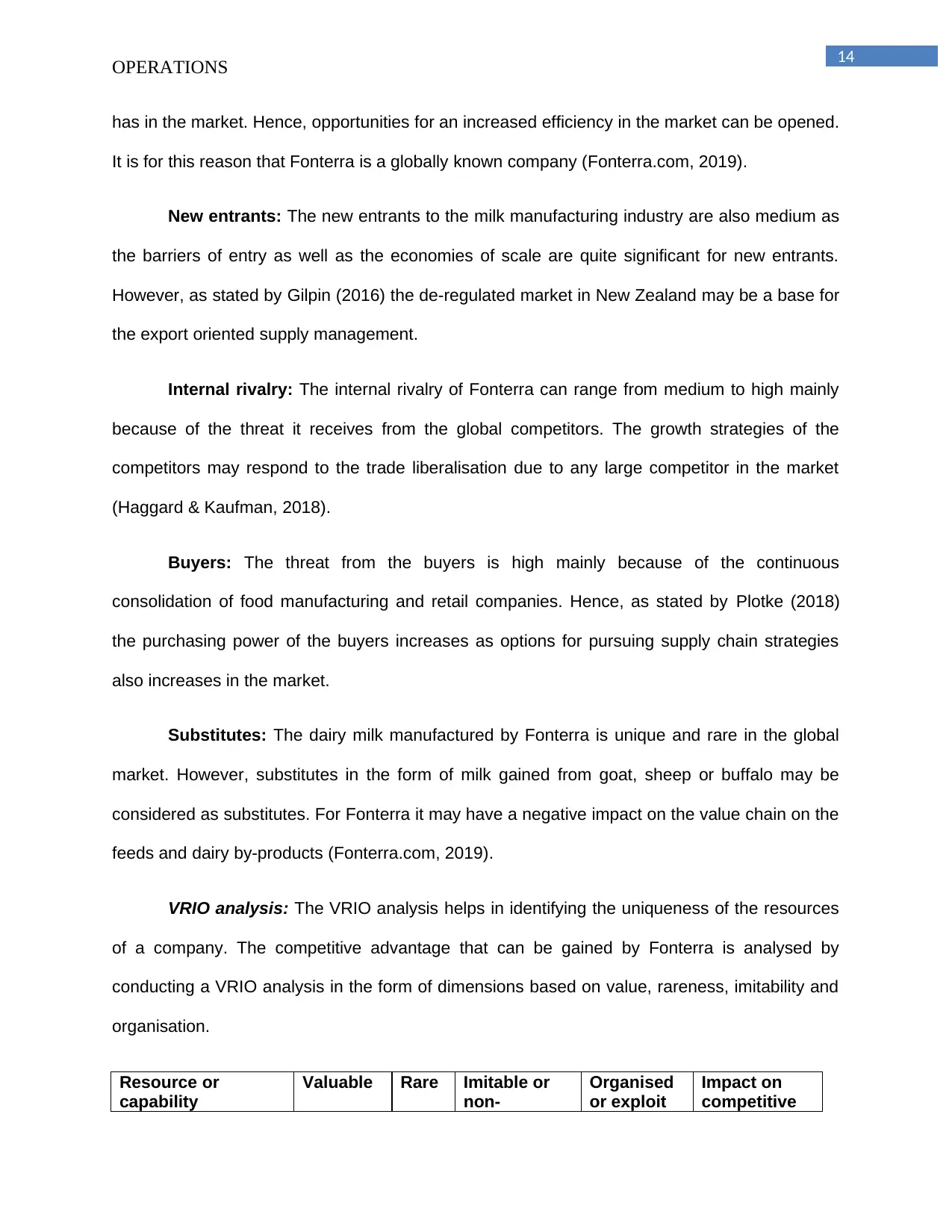
14
OPERATIONS
has in the market. Hence, opportunities for an increased efficiency in the market can be opened.
It is for this reason that Fonterra is a globally known company (Fonterra.com, 2019).
New entrants: The new entrants to the milk manufacturing industry are also medium as
the barriers of entry as well as the economies of scale are quite significant for new entrants.
However, as stated by Gilpin (2016) the de-regulated market in New Zealand may be a base for
the export oriented supply management.
Internal rivalry: The internal rivalry of Fonterra can range from medium to high mainly
because of the threat it receives from the global competitors. The growth strategies of the
competitors may respond to the trade liberalisation due to any large competitor in the market
(Haggard & Kaufman, 2018).
Buyers: The threat from the buyers is high mainly because of the continuous
consolidation of food manufacturing and retail companies. Hence, as stated by Plotke (2018)
the purchasing power of the buyers increases as options for pursuing supply chain strategies
also increases in the market.
Substitutes: The dairy milk manufactured by Fonterra is unique and rare in the global
market. However, substitutes in the form of milk gained from goat, sheep or buffalo may be
considered as substitutes. For Fonterra it may have a negative impact on the value chain on the
feeds and dairy by-products (Fonterra.com, 2019).
VRIO analysis: The VRIO analysis helps in identifying the uniqueness of the resources
of a company. The competitive advantage that can be gained by Fonterra is analysed by
conducting a VRIO analysis in the form of dimensions based on value, rareness, imitability and
organisation.
Resource or
capability
Valuable Rare Imitable or
non-
Organised
or exploit
Impact on
competitive
OPERATIONS
has in the market. Hence, opportunities for an increased efficiency in the market can be opened.
It is for this reason that Fonterra is a globally known company (Fonterra.com, 2019).
New entrants: The new entrants to the milk manufacturing industry are also medium as
the barriers of entry as well as the economies of scale are quite significant for new entrants.
However, as stated by Gilpin (2016) the de-regulated market in New Zealand may be a base for
the export oriented supply management.
Internal rivalry: The internal rivalry of Fonterra can range from medium to high mainly
because of the threat it receives from the global competitors. The growth strategies of the
competitors may respond to the trade liberalisation due to any large competitor in the market
(Haggard & Kaufman, 2018).
Buyers: The threat from the buyers is high mainly because of the continuous
consolidation of food manufacturing and retail companies. Hence, as stated by Plotke (2018)
the purchasing power of the buyers increases as options for pursuing supply chain strategies
also increases in the market.
Substitutes: The dairy milk manufactured by Fonterra is unique and rare in the global
market. However, substitutes in the form of milk gained from goat, sheep or buffalo may be
considered as substitutes. For Fonterra it may have a negative impact on the value chain on the
feeds and dairy by-products (Fonterra.com, 2019).
VRIO analysis: The VRIO analysis helps in identifying the uniqueness of the resources
of a company. The competitive advantage that can be gained by Fonterra is analysed by
conducting a VRIO analysis in the form of dimensions based on value, rareness, imitability and
organisation.
Resource or
capability
Valuable Rare Imitable or
non-
Organised
or exploit
Impact on
competitive
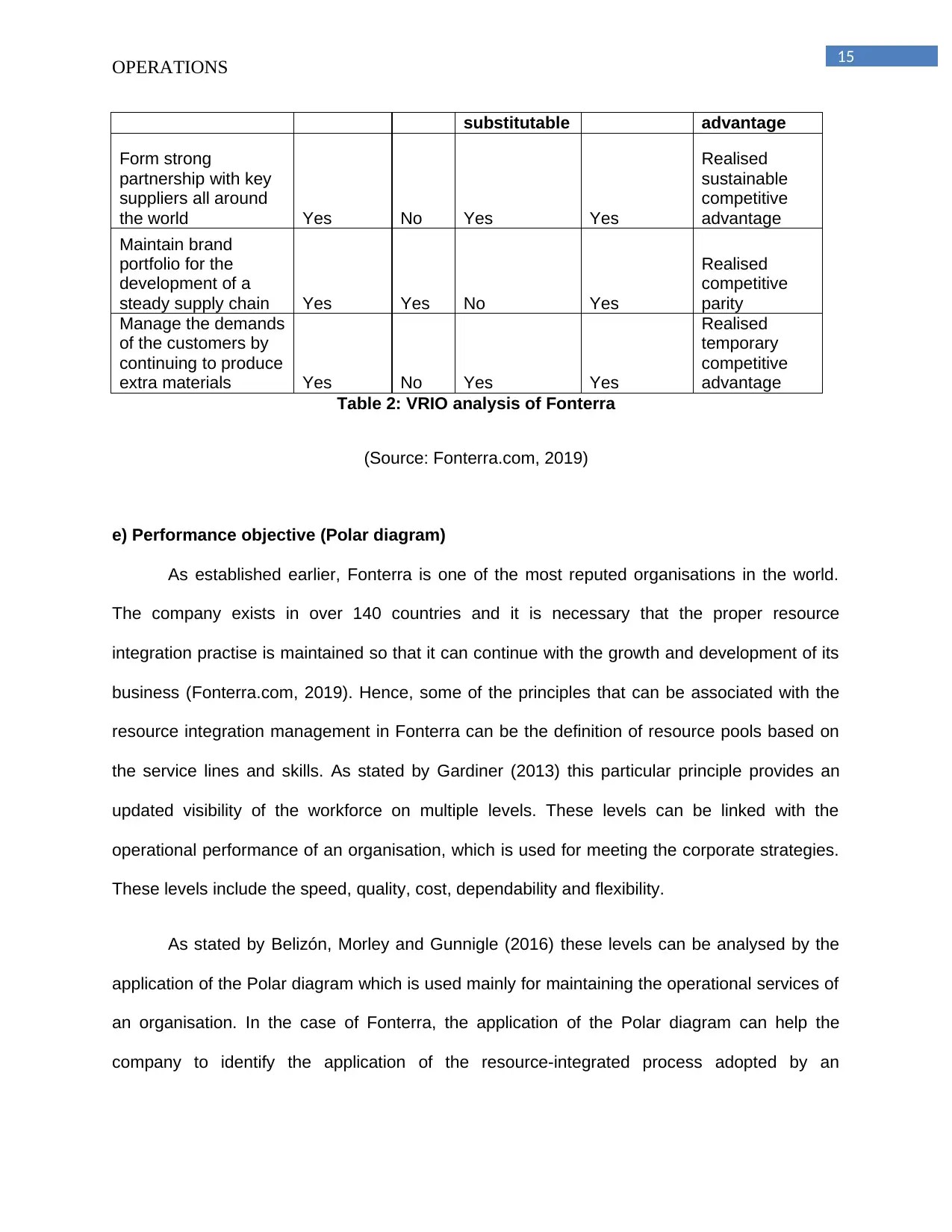
15
OPERATIONS
substitutable advantage
Form strong
partnership with key
suppliers all around
the world Yes No Yes Yes
Realised
sustainable
competitive
advantage
Maintain brand
portfolio for the
development of a
steady supply chain Yes Yes No Yes
Realised
competitive
parity
Manage the demands
of the customers by
continuing to produce
extra materials Yes No Yes Yes
Realised
temporary
competitive
advantage
Table 2: VRIO analysis of Fonterra
(Source: Fonterra.com, 2019)
e) Performance objective (Polar diagram)
As established earlier, Fonterra is one of the most reputed organisations in the world.
The company exists in over 140 countries and it is necessary that the proper resource
integration practise is maintained so that it can continue with the growth and development of its
business (Fonterra.com, 2019). Hence, some of the principles that can be associated with the
resource integration management in Fonterra can be the definition of resource pools based on
the service lines and skills. As stated by Gardiner (2013) this particular principle provides an
updated visibility of the workforce on multiple levels. These levels can be linked with the
operational performance of an organisation, which is used for meeting the corporate strategies.
These levels include the speed, quality, cost, dependability and flexibility.
As stated by Belizón, Morley and Gunnigle (2016) these levels can be analysed by the
application of the Polar diagram which is used mainly for maintaining the operational services of
an organisation. In the case of Fonterra, the application of the Polar diagram can help the
company to identify the application of the resource-integrated process adopted by an
OPERATIONS
substitutable advantage
Form strong
partnership with key
suppliers all around
the world Yes No Yes Yes
Realised
sustainable
competitive
advantage
Maintain brand
portfolio for the
development of a
steady supply chain Yes Yes No Yes
Realised
competitive
parity
Manage the demands
of the customers by
continuing to produce
extra materials Yes No Yes Yes
Realised
temporary
competitive
advantage
Table 2: VRIO analysis of Fonterra
(Source: Fonterra.com, 2019)
e) Performance objective (Polar diagram)
As established earlier, Fonterra is one of the most reputed organisations in the world.
The company exists in over 140 countries and it is necessary that the proper resource
integration practise is maintained so that it can continue with the growth and development of its
business (Fonterra.com, 2019). Hence, some of the principles that can be associated with the
resource integration management in Fonterra can be the definition of resource pools based on
the service lines and skills. As stated by Gardiner (2013) this particular principle provides an
updated visibility of the workforce on multiple levels. These levels can be linked with the
operational performance of an organisation, which is used for meeting the corporate strategies.
These levels include the speed, quality, cost, dependability and flexibility.
As stated by Belizón, Morley and Gunnigle (2016) these levels can be analysed by the
application of the Polar diagram which is used mainly for maintaining the operational services of
an organisation. In the case of Fonterra, the application of the Polar diagram can help the
company to identify the application of the resource-integrated process adopted by an
Secure Best Marks with AI Grader
Need help grading? Try our AI Grader for instant feedback on your assignments.

16
OPERATIONS
organisation. The levels or factors associated with the Polar diagram can be considered
separately for identifying the effective practise used by Fonterra.
Speed: The objective of speed provides an analysis about the delivery time of the
products of a company (Noe et al., 2017). In the case of Fonterra, it has been seen that the
company collects 14 million litres of milk in a day and can produce up to 20 metric tonnes of
powder (Fonterra.com, 2019). Therefore, the speed at which the products are manufactured
and delivered to the customers can be considered as high. Hence, it can be said that for
Fonterra the speed of the manufacturing of the products are an asset since the company have
productive employees among their ranks (Fonterra.com, 2019).
Quality: As stated by Wright (2018) the quality defines the manner in which a product
meets the expectations and specifications. This may include an analysis of the customers, as
the expectations are high from the organisations. In the case of Fonterra, the quality of the milk
products manufactured by the company is high mainly because the company have knowledge
about the tastes and preferences of the customers due to the marketing team that is associated
with it (Fonterra.com, 2019). The team provides feedback about the requirements of the
customers therefore, increasing the quality of Fonterra (Fonterra.com, 2019).
Cost: The cost signifies the rate at which products are sold in the market. The cost takes
into consideration two factors that include the quantity and quality of the products. Variety of a
single product tends to sport lower volumes at a higher unit cost (Bratton & Gold, 2017).
Fonterra usually generates profit from the milk products due to the reputation it has in the
business. However, at time factors such as the economic and financial stability of the people
tend to bring down the profit level as is evidenced from the loss suffered by company in 2018
(Fonterra.com, 2019).
OPERATIONS
organisation. The levels or factors associated with the Polar diagram can be considered
separately for identifying the effective practise used by Fonterra.
Speed: The objective of speed provides an analysis about the delivery time of the
products of a company (Noe et al., 2017). In the case of Fonterra, it has been seen that the
company collects 14 million litres of milk in a day and can produce up to 20 metric tonnes of
powder (Fonterra.com, 2019). Therefore, the speed at which the products are manufactured
and delivered to the customers can be considered as high. Hence, it can be said that for
Fonterra the speed of the manufacturing of the products are an asset since the company have
productive employees among their ranks (Fonterra.com, 2019).
Quality: As stated by Wright (2018) the quality defines the manner in which a product
meets the expectations and specifications. This may include an analysis of the customers, as
the expectations are high from the organisations. In the case of Fonterra, the quality of the milk
products manufactured by the company is high mainly because the company have knowledge
about the tastes and preferences of the customers due to the marketing team that is associated
with it (Fonterra.com, 2019). The team provides feedback about the requirements of the
customers therefore, increasing the quality of Fonterra (Fonterra.com, 2019).
Cost: The cost signifies the rate at which products are sold in the market. The cost takes
into consideration two factors that include the quantity and quality of the products. Variety of a
single product tends to sport lower volumes at a higher unit cost (Bratton & Gold, 2017).
Fonterra usually generates profit from the milk products due to the reputation it has in the
business. However, at time factors such as the economic and financial stability of the people
tend to bring down the profit level as is evidenced from the loss suffered by company in 2018
(Fonterra.com, 2019).

17
OPERATIONS
Flexibility: Flexible operations help in the configuration of the product lines so hat
various requirements can be met. Fonterra need to adjust to the product lines quickly so that
new requirements from the customers can be met. Fonterra is considered as a successful
company that maintains a balance between the demands and supply. The company is flexible in
terms of managing its inventory as well as the supply chain operations that exist within it
(Fonterra.com, 2019). The flexibility is mainly due to the financial strength of the company as it
helps in dictating the outcome associated with the balance and flexibility of the market
requirements.
Dependability: According to DeCenzo, Robbins and Verhulst (2016), this particular
operation defines the reliability of a company in terms of delivering a product on time. It has
already been established that Fonterra have a quality speed in terms of manufacturing the
products. Hence, the dependability factor of the company in terms of delivering the products is
high. It is for this reason that the company earned revenue of NZD 734 million in 2017
(Fonterra.com, 2019). However, in 2018, the company had failed to live up to the expectations
from the customers.
Therefore, it can be said that the application of these factors in Fonterra can be aligned
with the development of resource pools that can have a severe impact on the development of
the company (Fonterra.com, 2019). The service skills required by the employees need to
comply with the requirements stated as per the levels of the Polar diagram. Every employee
need to be well versed with the type of products that exist in the organisation and the manner in
which improvements to some of the factors like the speed of the services can be improved.
OPERATIONS
Flexibility: Flexible operations help in the configuration of the product lines so hat
various requirements can be met. Fonterra need to adjust to the product lines quickly so that
new requirements from the customers can be met. Fonterra is considered as a successful
company that maintains a balance between the demands and supply. The company is flexible in
terms of managing its inventory as well as the supply chain operations that exist within it
(Fonterra.com, 2019). The flexibility is mainly due to the financial strength of the company as it
helps in dictating the outcome associated with the balance and flexibility of the market
requirements.
Dependability: According to DeCenzo, Robbins and Verhulst (2016), this particular
operation defines the reliability of a company in terms of delivering a product on time. It has
already been established that Fonterra have a quality speed in terms of manufacturing the
products. Hence, the dependability factor of the company in terms of delivering the products is
high. It is for this reason that the company earned revenue of NZD 734 million in 2017
(Fonterra.com, 2019). However, in 2018, the company had failed to live up to the expectations
from the customers.
Therefore, it can be said that the application of these factors in Fonterra can be aligned
with the development of resource pools that can have a severe impact on the development of
the company (Fonterra.com, 2019). The service skills required by the employees need to
comply with the requirements stated as per the levels of the Polar diagram. Every employee
need to be well versed with the type of products that exist in the organisation and the manner in
which improvements to some of the factors like the speed of the services can be improved.
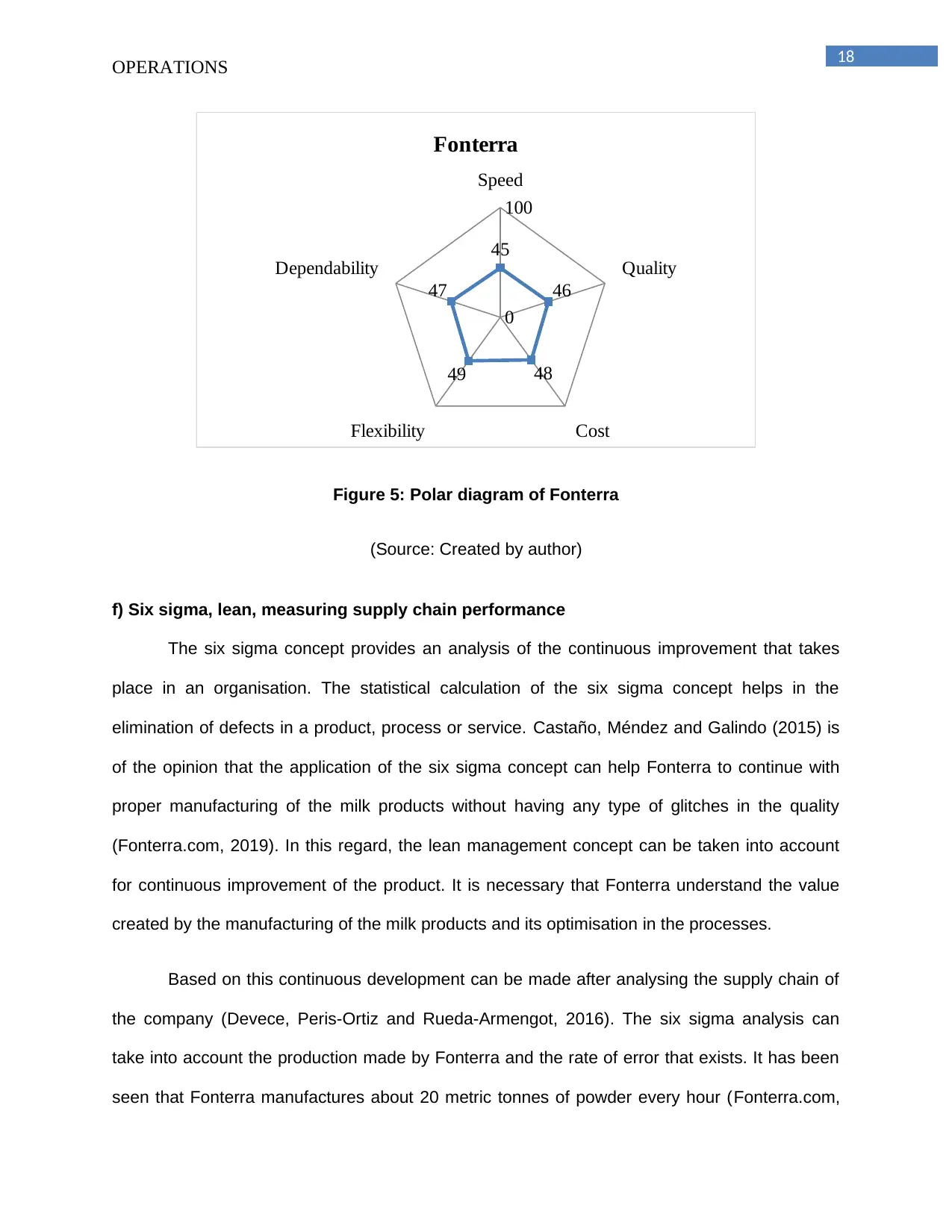
18
OPERATIONS
Speed
Quality
CostFlexibility
Dependability
0
100
45
46
4849
47
Fonterra
Figure 5: Polar diagram of Fonterra
(Source: Created by author)
f) Six sigma, lean, measuring supply chain performance
The six sigma concept provides an analysis of the continuous improvement that takes
place in an organisation. The statistical calculation of the six sigma concept helps in the
elimination of defects in a product, process or service. Castaño, Méndez and Galindo (2015) is
of the opinion that the application of the six sigma concept can help Fonterra to continue with
proper manufacturing of the milk products without having any type of glitches in the quality
(Fonterra.com, 2019). In this regard, the lean management concept can be taken into account
for continuous improvement of the product. It is necessary that Fonterra understand the value
created by the manufacturing of the milk products and its optimisation in the processes.
Based on this continuous development can be made after analysing the supply chain of
the company (Devece, Peris-Ortiz and Rueda-Armengot, 2016). The six sigma analysis can
take into account the production made by Fonterra and the rate of error that exists. It has been
seen that Fonterra manufactures about 20 metric tonnes of powder every hour (Fonterra.com,
OPERATIONS
Speed
Quality
CostFlexibility
Dependability
0
100
45
46
4849
47
Fonterra
Figure 5: Polar diagram of Fonterra
(Source: Created by author)
f) Six sigma, lean, measuring supply chain performance
The six sigma concept provides an analysis of the continuous improvement that takes
place in an organisation. The statistical calculation of the six sigma concept helps in the
elimination of defects in a product, process or service. Castaño, Méndez and Galindo (2015) is
of the opinion that the application of the six sigma concept can help Fonterra to continue with
proper manufacturing of the milk products without having any type of glitches in the quality
(Fonterra.com, 2019). In this regard, the lean management concept can be taken into account
for continuous improvement of the product. It is necessary that Fonterra understand the value
created by the manufacturing of the milk products and its optimisation in the processes.
Based on this continuous development can be made after analysing the supply chain of
the company (Devece, Peris-Ortiz and Rueda-Armengot, 2016). The six sigma analysis can
take into account the production made by Fonterra and the rate of error that exists. It has been
seen that Fonterra manufactures about 20 metric tonnes of powder every hour (Fonterra.com,
Paraphrase This Document
Need a fresh take? Get an instant paraphrase of this document with our AI Paraphraser

19
OPERATIONS
2019). Therefore, it can be said that the rate of production of the milk powder is about 420,000
metric tonnes (Fonterra.com, 2019). Hence, the opportunities for increase in error can be high
due to the fast rate of manufacture.
However, the supply chain flow needs to be measured so that Fonterra can understand
the necessary changes that are required to be met in the company (Fonterra.com, 2019). The
implementation of proper retail channels could help in the development of the supply chain and
based on the urgency of the customers, Fonterra can continue with the lean manufacturing of
the product.
g) Financial risks and Cost benefit analysis
The financial risks that can be analysed from the calculation of the balance sheet is
based on the current ratio and the acid test ratio.
OPERATIONS
2019). Therefore, it can be said that the rate of production of the milk powder is about 420,000
metric tonnes (Fonterra.com, 2019). Hence, the opportunities for increase in error can be high
due to the fast rate of manufacture.
However, the supply chain flow needs to be measured so that Fonterra can understand
the necessary changes that are required to be met in the company (Fonterra.com, 2019). The
implementation of proper retail channels could help in the development of the supply chain and
based on the urgency of the customers, Fonterra can continue with the lean manufacturing of
the product.
g) Financial risks and Cost benefit analysis
The financial risks that can be analysed from the calculation of the balance sheet is
based on the current ratio and the acid test ratio.
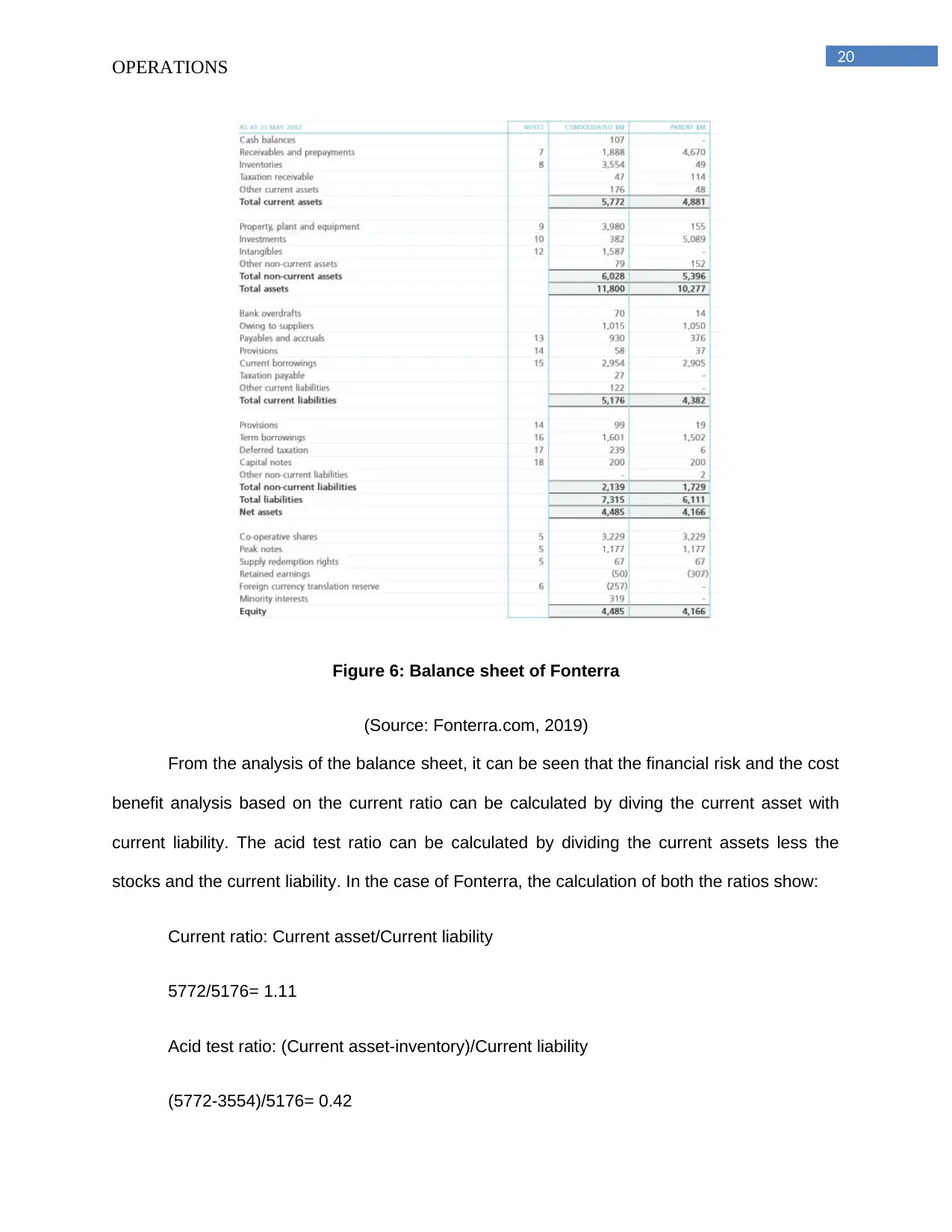
20
OPERATIONS
Figure 6: Balance sheet of Fonterra
(Source: Fonterra.com, 2019)
From the analysis of the balance sheet, it can be seen that the financial risk and the cost
benefit analysis based on the current ratio can be calculated by diving the current asset with
current liability. The acid test ratio can be calculated by dividing the current assets less the
stocks and the current liability. In the case of Fonterra, the calculation of both the ratios show:
Current ratio: Current asset/Current liability
5772/5176= 1.11
Acid test ratio: (Current asset-inventory)/Current liability
(5772-3554)/5176= 0.42
OPERATIONS
Figure 6: Balance sheet of Fonterra
(Source: Fonterra.com, 2019)
From the analysis of the balance sheet, it can be seen that the financial risk and the cost
benefit analysis based on the current ratio can be calculated by diving the current asset with
current liability. The acid test ratio can be calculated by dividing the current assets less the
stocks and the current liability. In the case of Fonterra, the calculation of both the ratios show:
Current ratio: Current asset/Current liability
5772/5176= 1.11
Acid test ratio: (Current asset-inventory)/Current liability
(5772-3554)/5176= 0.42
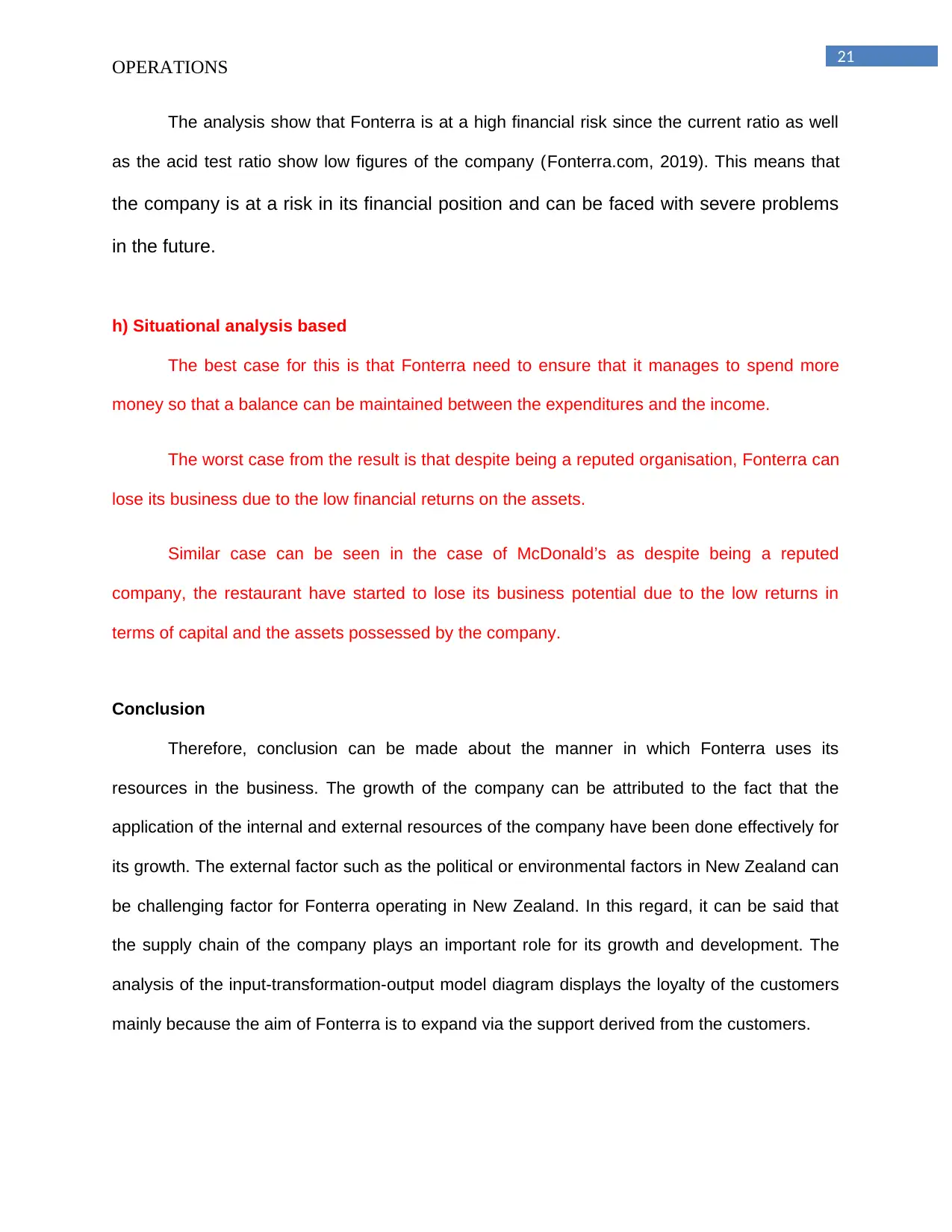
21
OPERATIONS
The analysis show that Fonterra is at a high financial risk since the current ratio as well
as the acid test ratio show low figures of the company (Fonterra.com, 2019). This means that
the company is at a risk in its financial position and can be faced with severe problems
in the future.
h) Situational analysis based
The best case for this is that Fonterra need to ensure that it manages to spend more
money so that a balance can be maintained between the expenditures and the income.
The worst case from the result is that despite being a reputed organisation, Fonterra can
lose its business due to the low financial returns on the assets.
Similar case can be seen in the case of McDonald’s as despite being a reputed
company, the restaurant have started to lose its business potential due to the low returns in
terms of capital and the assets possessed by the company.
Conclusion
Therefore, conclusion can be made about the manner in which Fonterra uses its
resources in the business. The growth of the company can be attributed to the fact that the
application of the internal and external resources of the company have been done effectively for
its growth. The external factor such as the political or environmental factors in New Zealand can
be challenging factor for Fonterra operating in New Zealand. In this regard, it can be said that
the supply chain of the company plays an important role for its growth and development. The
analysis of the input-transformation-output model diagram displays the loyalty of the customers
mainly because the aim of Fonterra is to expand via the support derived from the customers.
OPERATIONS
The analysis show that Fonterra is at a high financial risk since the current ratio as well
as the acid test ratio show low figures of the company (Fonterra.com, 2019). This means that
the company is at a risk in its financial position and can be faced with severe problems
in the future.
h) Situational analysis based
The best case for this is that Fonterra need to ensure that it manages to spend more
money so that a balance can be maintained between the expenditures and the income.
The worst case from the result is that despite being a reputed organisation, Fonterra can
lose its business due to the low financial returns on the assets.
Similar case can be seen in the case of McDonald’s as despite being a reputed
company, the restaurant have started to lose its business potential due to the low returns in
terms of capital and the assets possessed by the company.
Conclusion
Therefore, conclusion can be made about the manner in which Fonterra uses its
resources in the business. The growth of the company can be attributed to the fact that the
application of the internal and external resources of the company have been done effectively for
its growth. The external factor such as the political or environmental factors in New Zealand can
be challenging factor for Fonterra operating in New Zealand. In this regard, it can be said that
the supply chain of the company plays an important role for its growth and development. The
analysis of the input-transformation-output model diagram displays the loyalty of the customers
mainly because the aim of Fonterra is to expand via the support derived from the customers.
Secure Best Marks with AI Grader
Need help grading? Try our AI Grader for instant feedback on your assignments.
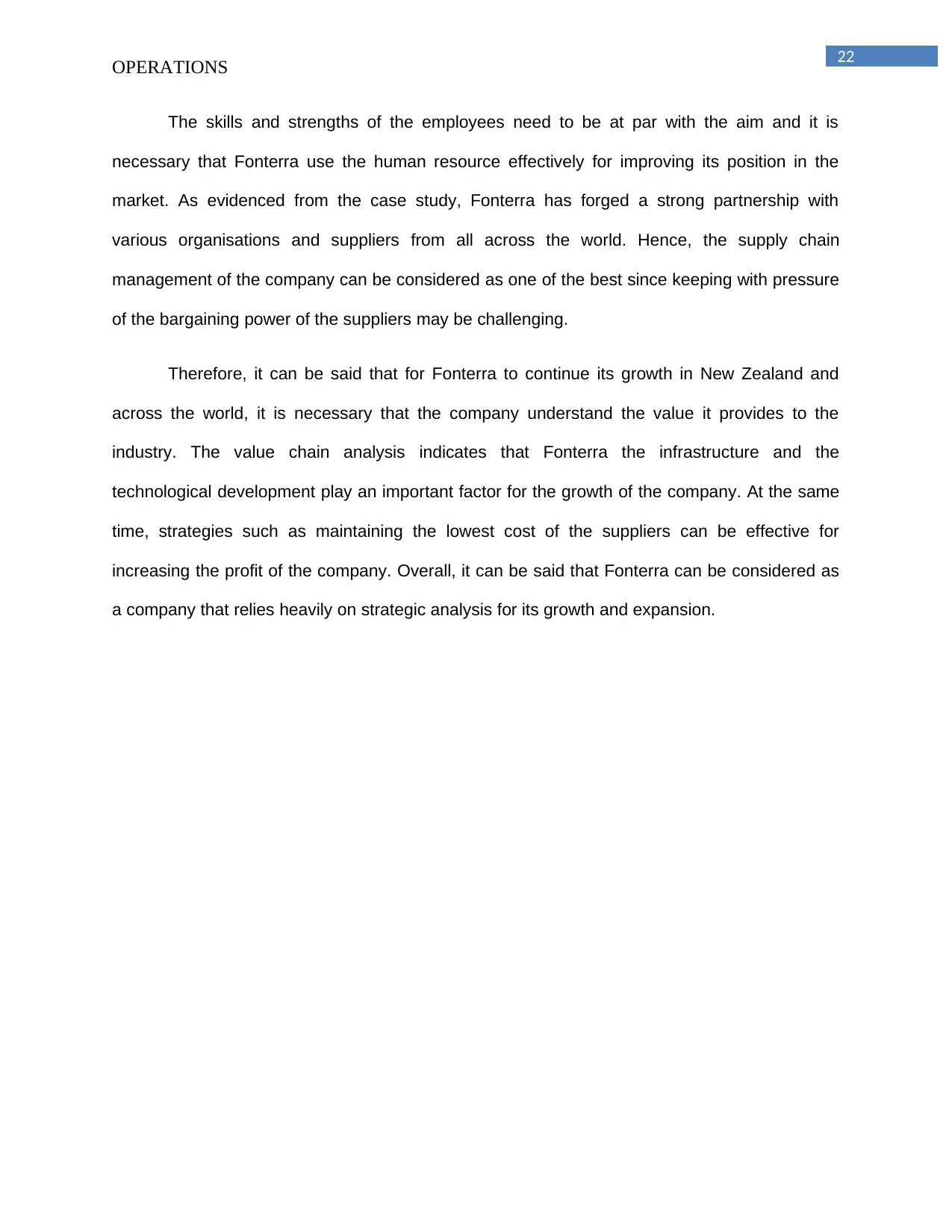
22
OPERATIONS
The skills and strengths of the employees need to be at par with the aim and it is
necessary that Fonterra use the human resource effectively for improving its position in the
market. As evidenced from the case study, Fonterra has forged a strong partnership with
various organisations and suppliers from all across the world. Hence, the supply chain
management of the company can be considered as one of the best since keeping with pressure
of the bargaining power of the suppliers may be challenging.
Therefore, it can be said that for Fonterra to continue its growth in New Zealand and
across the world, it is necessary that the company understand the value it provides to the
industry. The value chain analysis indicates that Fonterra the infrastructure and the
technological development play an important factor for the growth of the company. At the same
time, strategies such as maintaining the lowest cost of the suppliers can be effective for
increasing the profit of the company. Overall, it can be said that Fonterra can be considered as
a company that relies heavily on strategic analysis for its growth and expansion.
OPERATIONS
The skills and strengths of the employees need to be at par with the aim and it is
necessary that Fonterra use the human resource effectively for improving its position in the
market. As evidenced from the case study, Fonterra has forged a strong partnership with
various organisations and suppliers from all across the world. Hence, the supply chain
management of the company can be considered as one of the best since keeping with pressure
of the bargaining power of the suppliers may be challenging.
Therefore, it can be said that for Fonterra to continue its growth in New Zealand and
across the world, it is necessary that the company understand the value it provides to the
industry. The value chain analysis indicates that Fonterra the infrastructure and the
technological development play an important factor for the growth of the company. At the same
time, strategies such as maintaining the lowest cost of the suppliers can be effective for
increasing the profit of the company. Overall, it can be said that Fonterra can be considered as
a company that relies heavily on strategic analysis for its growth and expansion.
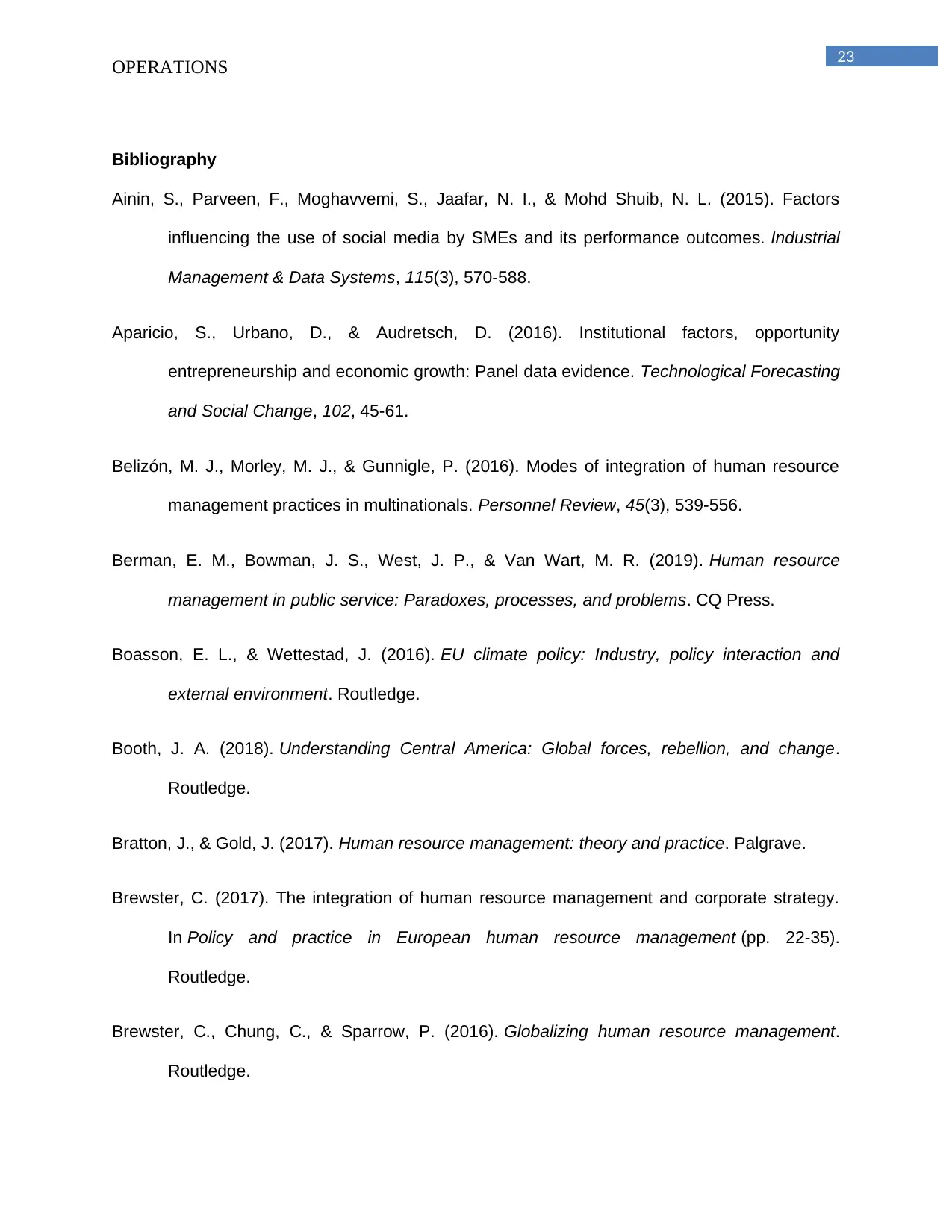
23
OPERATIONS
Bibliography
Ainin, S., Parveen, F., Moghavvemi, S., Jaafar, N. I., & Mohd Shuib, N. L. (2015). Factors
influencing the use of social media by SMEs and its performance outcomes. Industrial
Management & Data Systems, 115(3), 570-588.
Aparicio, S., Urbano, D., & Audretsch, D. (2016). Institutional factors, opportunity
entrepreneurship and economic growth: Panel data evidence. Technological Forecasting
and Social Change, 102, 45-61.
Belizón, M. J., Morley, M. J., & Gunnigle, P. (2016). Modes of integration of human resource
management practices in multinationals. Personnel Review, 45(3), 539-556.
Berman, E. M., Bowman, J. S., West, J. P., & Van Wart, M. R. (2019). Human resource
management in public service: Paradoxes, processes, and problems. CQ Press.
Boasson, E. L., & Wettestad, J. (2016). EU climate policy: Industry, policy interaction and
external environment. Routledge.
Booth, J. A. (2018). Understanding Central America: Global forces, rebellion, and change.
Routledge.
Bratton, J., & Gold, J. (2017). Human resource management: theory and practice. Palgrave.
Brewster, C. (2017). The integration of human resource management and corporate strategy.
In Policy and practice in European human resource management (pp. 22-35).
Routledge.
Brewster, C., Chung, C., & Sparrow, P. (2016). Globalizing human resource management.
Routledge.
OPERATIONS
Bibliography
Ainin, S., Parveen, F., Moghavvemi, S., Jaafar, N. I., & Mohd Shuib, N. L. (2015). Factors
influencing the use of social media by SMEs and its performance outcomes. Industrial
Management & Data Systems, 115(3), 570-588.
Aparicio, S., Urbano, D., & Audretsch, D. (2016). Institutional factors, opportunity
entrepreneurship and economic growth: Panel data evidence. Technological Forecasting
and Social Change, 102, 45-61.
Belizón, M. J., Morley, M. J., & Gunnigle, P. (2016). Modes of integration of human resource
management practices in multinationals. Personnel Review, 45(3), 539-556.
Berman, E. M., Bowman, J. S., West, J. P., & Van Wart, M. R. (2019). Human resource
management in public service: Paradoxes, processes, and problems. CQ Press.
Boasson, E. L., & Wettestad, J. (2016). EU climate policy: Industry, policy interaction and
external environment. Routledge.
Booth, J. A. (2018). Understanding Central America: Global forces, rebellion, and change.
Routledge.
Bratton, J., & Gold, J. (2017). Human resource management: theory and practice. Palgrave.
Brewster, C. (2017). The integration of human resource management and corporate strategy.
In Policy and practice in European human resource management (pp. 22-35).
Routledge.
Brewster, C., Chung, C., & Sparrow, P. (2016). Globalizing human resource management.
Routledge.
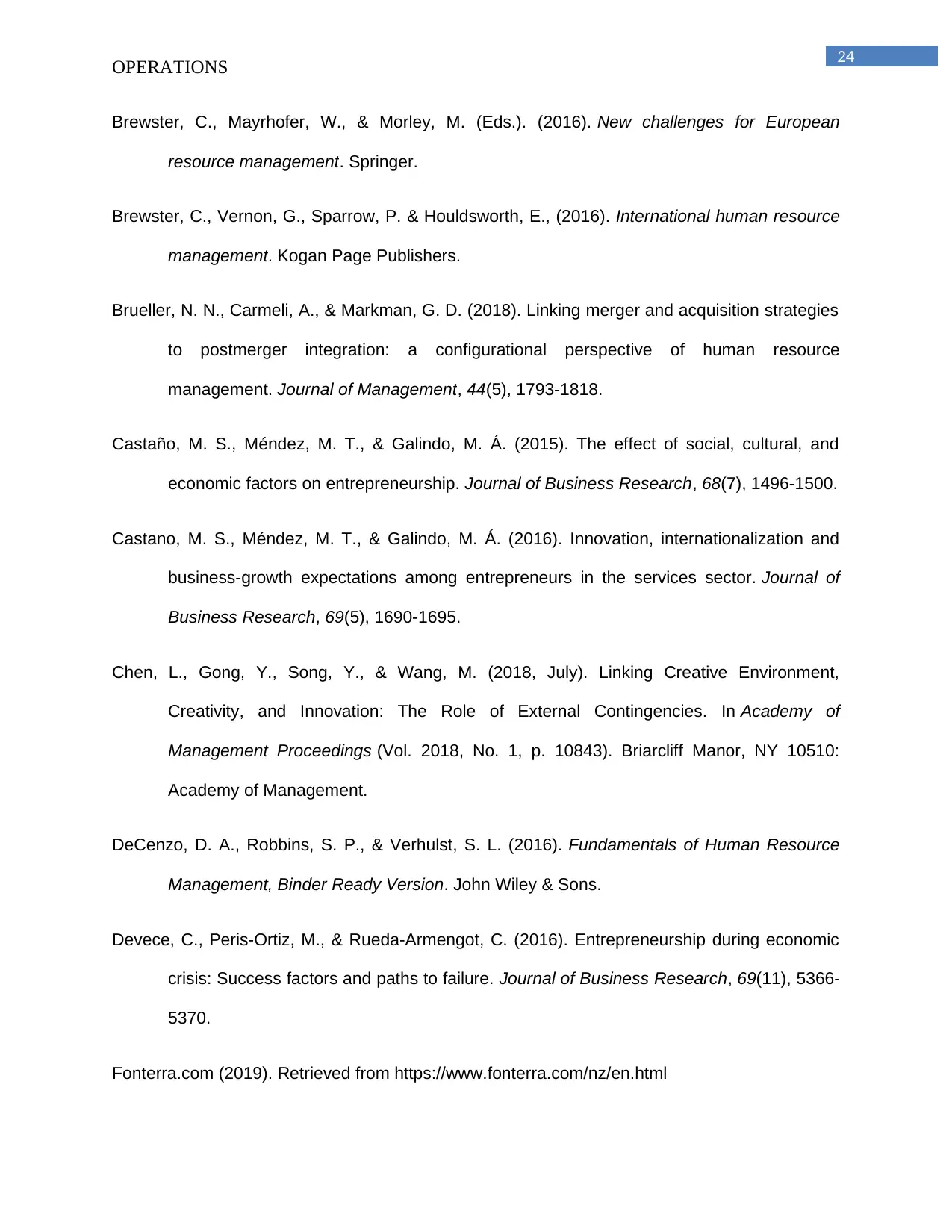
24
OPERATIONS
Brewster, C., Mayrhofer, W., & Morley, M. (Eds.). (2016). New challenges for European
resource management. Springer.
Brewster, C., Vernon, G., Sparrow, P. & Houldsworth, E., (2016). International human resource
management. Kogan Page Publishers.
Brueller, N. N., Carmeli, A., & Markman, G. D. (2018). Linking merger and acquisition strategies
to postmerger integration: a configurational perspective of human resource
management. Journal of Management, 44(5), 1793-1818.
Castaño, M. S., Méndez, M. T., & Galindo, M. Á. (2015). The effect of social, cultural, and
economic factors on entrepreneurship. Journal of Business Research, 68(7), 1496-1500.
Castano, M. S., Méndez, M. T., & Galindo, M. Á. (2016). Innovation, internationalization and
business-growth expectations among entrepreneurs in the services sector. Journal of
Business Research, 69(5), 1690-1695.
Chen, L., Gong, Y., Song, Y., & Wang, M. (2018, July). Linking Creative Environment,
Creativity, and Innovation: The Role of External Contingencies. In Academy of
Management Proceedings (Vol. 2018, No. 1, p. 10843). Briarcliff Manor, NY 10510:
Academy of Management.
DeCenzo, D. A., Robbins, S. P., & Verhulst, S. L. (2016). Fundamentals of Human Resource
Management, Binder Ready Version. John Wiley & Sons.
Devece, C., Peris-Ortiz, M., & Rueda-Armengot, C. (2016). Entrepreneurship during economic
crisis: Success factors and paths to failure. Journal of Business Research, 69(11), 5366-
5370.
Fonterra.com (2019). Retrieved from https://www.fonterra.com/nz/en.html
OPERATIONS
Brewster, C., Mayrhofer, W., & Morley, M. (Eds.). (2016). New challenges for European
resource management. Springer.
Brewster, C., Vernon, G., Sparrow, P. & Houldsworth, E., (2016). International human resource
management. Kogan Page Publishers.
Brueller, N. N., Carmeli, A., & Markman, G. D. (2018). Linking merger and acquisition strategies
to postmerger integration: a configurational perspective of human resource
management. Journal of Management, 44(5), 1793-1818.
Castaño, M. S., Méndez, M. T., & Galindo, M. Á. (2015). The effect of social, cultural, and
economic factors on entrepreneurship. Journal of Business Research, 68(7), 1496-1500.
Castano, M. S., Méndez, M. T., & Galindo, M. Á. (2016). Innovation, internationalization and
business-growth expectations among entrepreneurs in the services sector. Journal of
Business Research, 69(5), 1690-1695.
Chen, L., Gong, Y., Song, Y., & Wang, M. (2018, July). Linking Creative Environment,
Creativity, and Innovation: The Role of External Contingencies. In Academy of
Management Proceedings (Vol. 2018, No. 1, p. 10843). Briarcliff Manor, NY 10510:
Academy of Management.
DeCenzo, D. A., Robbins, S. P., & Verhulst, S. L. (2016). Fundamentals of Human Resource
Management, Binder Ready Version. John Wiley & Sons.
Devece, C., Peris-Ortiz, M., & Rueda-Armengot, C. (2016). Entrepreneurship during economic
crisis: Success factors and paths to failure. Journal of Business Research, 69(11), 5366-
5370.
Fonterra.com (2019). Retrieved from https://www.fonterra.com/nz/en.html
Paraphrase This Document
Need a fresh take? Get an instant paraphrase of this document with our AI Paraphraser
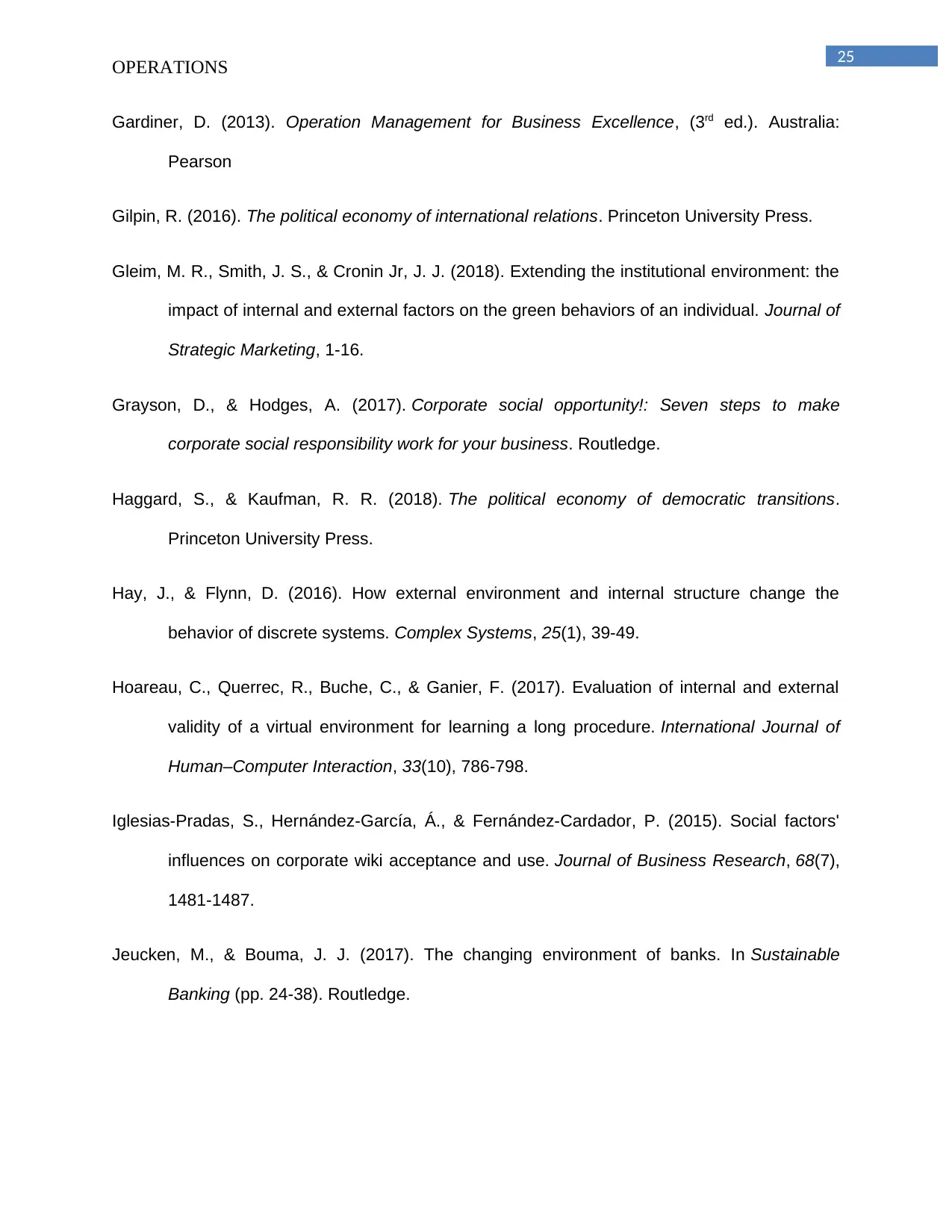
25
OPERATIONS
Gardiner, D. (2013). Operation Management for Business Excellence, (3rd ed.). Australia:
Pearson
Gilpin, R. (2016). The political economy of international relations. Princeton University Press.
Gleim, M. R., Smith, J. S., & Cronin Jr, J. J. (2018). Extending the institutional environment: the
impact of internal and external factors on the green behaviors of an individual. Journal of
Strategic Marketing, 1-16.
Grayson, D., & Hodges, A. (2017). Corporate social opportunity!: Seven steps to make
corporate social responsibility work for your business. Routledge.
Haggard, S., & Kaufman, R. R. (2018). The political economy of democratic transitions.
Princeton University Press.
Hay, J., & Flynn, D. (2016). How external environment and internal structure change the
behavior of discrete systems. Complex Systems, 25(1), 39-49.
Hoareau, C., Querrec, R., Buche, C., & Ganier, F. (2017). Evaluation of internal and external
validity of a virtual environment for learning a long procedure. International Journal of
Human–Computer Interaction, 33(10), 786-798.
Iglesias-Pradas, S., Hernández-García, Á., & Fernández-Cardador, P. (2015). Social factors'
influences on corporate wiki acceptance and use. Journal of Business Research, 68(7),
1481-1487.
Jeucken, M., & Bouma, J. J. (2017). The changing environment of banks. In Sustainable
Banking (pp. 24-38). Routledge.
OPERATIONS
Gardiner, D. (2013). Operation Management for Business Excellence, (3rd ed.). Australia:
Pearson
Gilpin, R. (2016). The political economy of international relations. Princeton University Press.
Gleim, M. R., Smith, J. S., & Cronin Jr, J. J. (2018). Extending the institutional environment: the
impact of internal and external factors on the green behaviors of an individual. Journal of
Strategic Marketing, 1-16.
Grayson, D., & Hodges, A. (2017). Corporate social opportunity!: Seven steps to make
corporate social responsibility work for your business. Routledge.
Haggard, S., & Kaufman, R. R. (2018). The political economy of democratic transitions.
Princeton University Press.
Hay, J., & Flynn, D. (2016). How external environment and internal structure change the
behavior of discrete systems. Complex Systems, 25(1), 39-49.
Hoareau, C., Querrec, R., Buche, C., & Ganier, F. (2017). Evaluation of internal and external
validity of a virtual environment for learning a long procedure. International Journal of
Human–Computer Interaction, 33(10), 786-798.
Iglesias-Pradas, S., Hernández-García, Á., & Fernández-Cardador, P. (2015). Social factors'
influences on corporate wiki acceptance and use. Journal of Business Research, 68(7),
1481-1487.
Jeucken, M., & Bouma, J. J. (2017). The changing environment of banks. In Sustainable
Banking (pp. 24-38). Routledge.
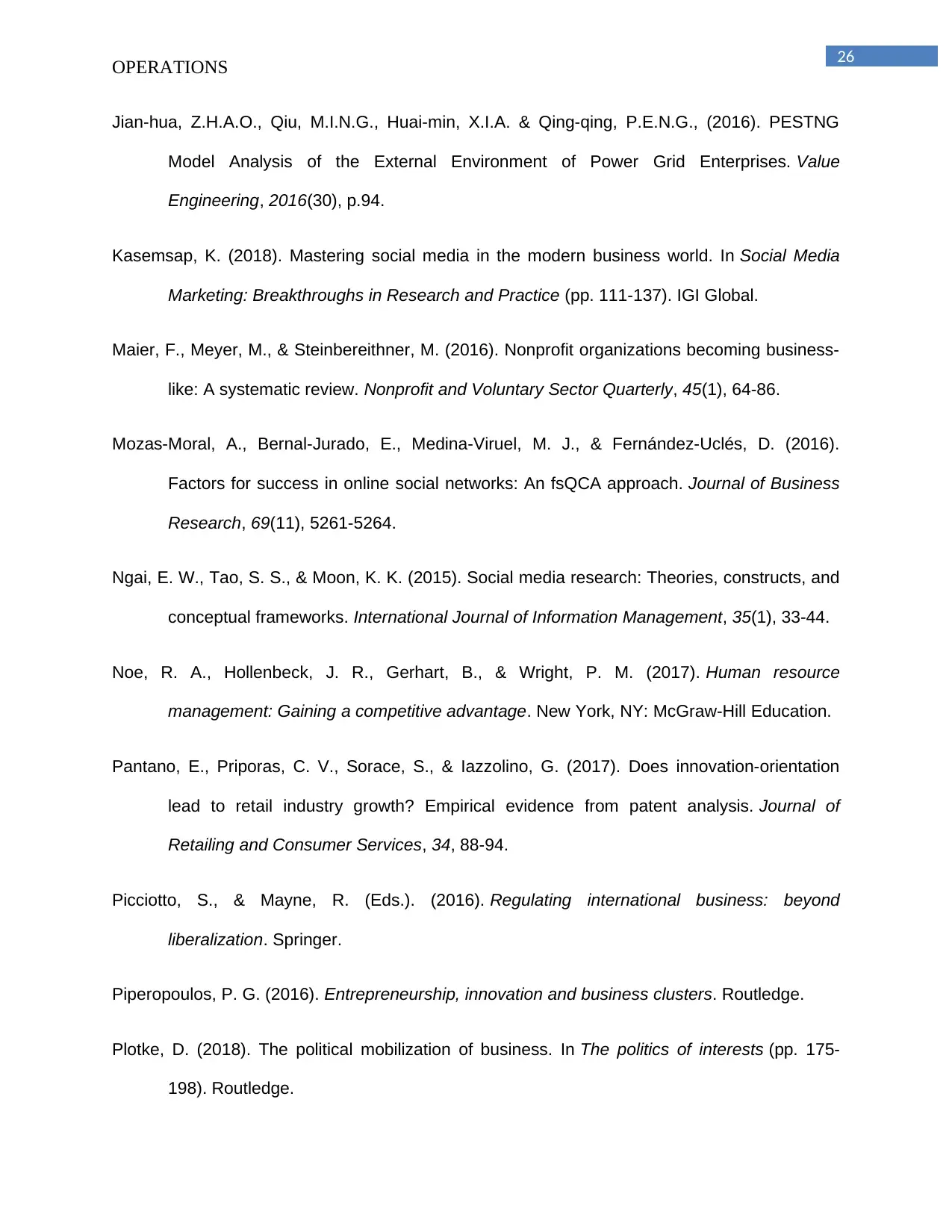
26
OPERATIONS
Jian-hua, Z.H.A.O., Qiu, M.I.N.G., Huai-min, X.I.A. & Qing-qing, P.E.N.G., (2016). PESTNG
Model Analysis of the External Environment of Power Grid Enterprises. Value
Engineering, 2016(30), p.94.
Kasemsap, K. (2018). Mastering social media in the modern business world. In Social Media
Marketing: Breakthroughs in Research and Practice (pp. 111-137). IGI Global.
Maier, F., Meyer, M., & Steinbereithner, M. (2016). Nonprofit organizations becoming business-
like: A systematic review. Nonprofit and Voluntary Sector Quarterly, 45(1), 64-86.
Mozas-Moral, A., Bernal-Jurado, E., Medina-Viruel, M. J., & Fernández-Uclés, D. (2016).
Factors for success in online social networks: An fsQCA approach. Journal of Business
Research, 69(11), 5261-5264.
Ngai, E. W., Tao, S. S., & Moon, K. K. (2015). Social media research: Theories, constructs, and
conceptual frameworks. International Journal of Information Management, 35(1), 33-44.
Noe, R. A., Hollenbeck, J. R., Gerhart, B., & Wright, P. M. (2017). Human resource
management: Gaining a competitive advantage. New York, NY: McGraw-Hill Education.
Pantano, E., Priporas, C. V., Sorace, S., & Iazzolino, G. (2017). Does innovation-orientation
lead to retail industry growth? Empirical evidence from patent analysis. Journal of
Retailing and Consumer Services, 34, 88-94.
Picciotto, S., & Mayne, R. (Eds.). (2016). Regulating international business: beyond
liberalization. Springer.
Piperopoulos, P. G. (2016). Entrepreneurship, innovation and business clusters. Routledge.
Plotke, D. (2018). The political mobilization of business. In The politics of interests (pp. 175-
198). Routledge.
OPERATIONS
Jian-hua, Z.H.A.O., Qiu, M.I.N.G., Huai-min, X.I.A. & Qing-qing, P.E.N.G., (2016). PESTNG
Model Analysis of the External Environment of Power Grid Enterprises. Value
Engineering, 2016(30), p.94.
Kasemsap, K. (2018). Mastering social media in the modern business world. In Social Media
Marketing: Breakthroughs in Research and Practice (pp. 111-137). IGI Global.
Maier, F., Meyer, M., & Steinbereithner, M. (2016). Nonprofit organizations becoming business-
like: A systematic review. Nonprofit and Voluntary Sector Quarterly, 45(1), 64-86.
Mozas-Moral, A., Bernal-Jurado, E., Medina-Viruel, M. J., & Fernández-Uclés, D. (2016).
Factors for success in online social networks: An fsQCA approach. Journal of Business
Research, 69(11), 5261-5264.
Ngai, E. W., Tao, S. S., & Moon, K. K. (2015). Social media research: Theories, constructs, and
conceptual frameworks. International Journal of Information Management, 35(1), 33-44.
Noe, R. A., Hollenbeck, J. R., Gerhart, B., & Wright, P. M. (2017). Human resource
management: Gaining a competitive advantage. New York, NY: McGraw-Hill Education.
Pantano, E., Priporas, C. V., Sorace, S., & Iazzolino, G. (2017). Does innovation-orientation
lead to retail industry growth? Empirical evidence from patent analysis. Journal of
Retailing and Consumer Services, 34, 88-94.
Picciotto, S., & Mayne, R. (Eds.). (2016). Regulating international business: beyond
liberalization. Springer.
Piperopoulos, P. G. (2016). Entrepreneurship, innovation and business clusters. Routledge.
Plotke, D. (2018). The political mobilization of business. In The politics of interests (pp. 175-
198). Routledge.

27
OPERATIONS
Schaltegger, S., & Wagner, M. (2017). Managing the business case for sustainability: The
integration of social, environmental and economic performance. Routledge.
Tsui, W. H. K., Balli, F., Tan, D. T. W., Lau, O., & Hasan, M. (2018). New Zealand business
tourism: Exploring the impact of economic policy uncertainties. Tourism
Economics, 24(4), 386-417.
Wang, F., & Zhang, X. P. S. (2015). The role of the Internet in changing industry
competition. Information & Management, 52(1), 71-81.
Wright, P. (2018). Fundamentals of human resource management. Management, 5, 27.
Zinovieva, C.G., Kuznetsova, M.V., Dorfman, T.V., Limarev, P.V. & Limareva, J.A., (2016).
Study of external and internal factors affecting enterprise’s stability. Advances in
Systems Science and Applications, 16(1), pp.62-71.
OPERATIONS
Schaltegger, S., & Wagner, M. (2017). Managing the business case for sustainability: The
integration of social, environmental and economic performance. Routledge.
Tsui, W. H. K., Balli, F., Tan, D. T. W., Lau, O., & Hasan, M. (2018). New Zealand business
tourism: Exploring the impact of economic policy uncertainties. Tourism
Economics, 24(4), 386-417.
Wang, F., & Zhang, X. P. S. (2015). The role of the Internet in changing industry
competition. Information & Management, 52(1), 71-81.
Wright, P. (2018). Fundamentals of human resource management. Management, 5, 27.
Zinovieva, C.G., Kuznetsova, M.V., Dorfman, T.V., Limarev, P.V. & Limareva, J.A., (2016).
Study of external and internal factors affecting enterprise’s stability. Advances in
Systems Science and Applications, 16(1), pp.62-71.
1 out of 28
Related Documents
Your All-in-One AI-Powered Toolkit for Academic Success.
+13062052269
info@desklib.com
Available 24*7 on WhatsApp / Email
![[object Object]](/_next/static/media/star-bottom.7253800d.svg)
Unlock your academic potential
© 2024 | Zucol Services PVT LTD | All rights reserved.





